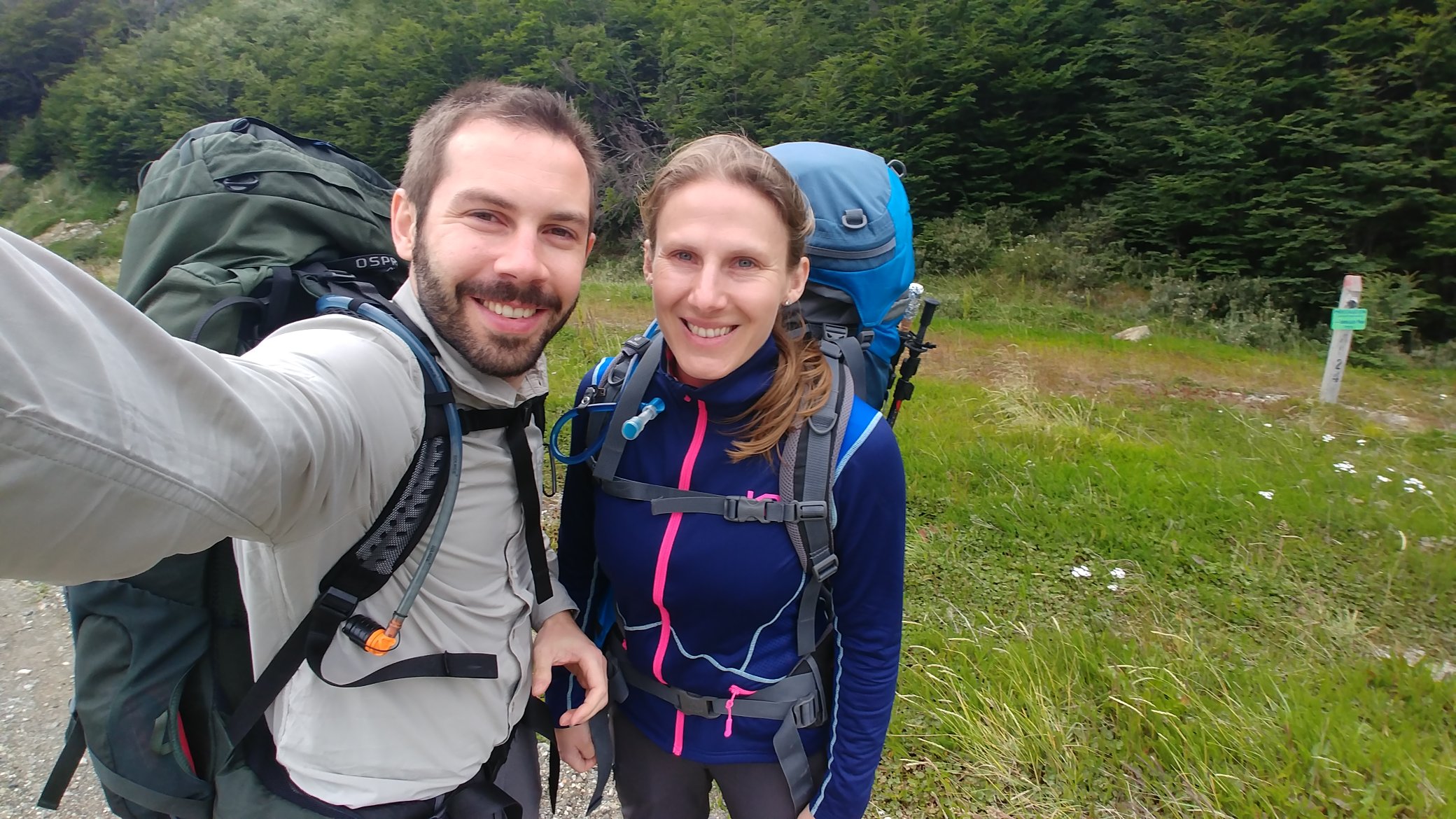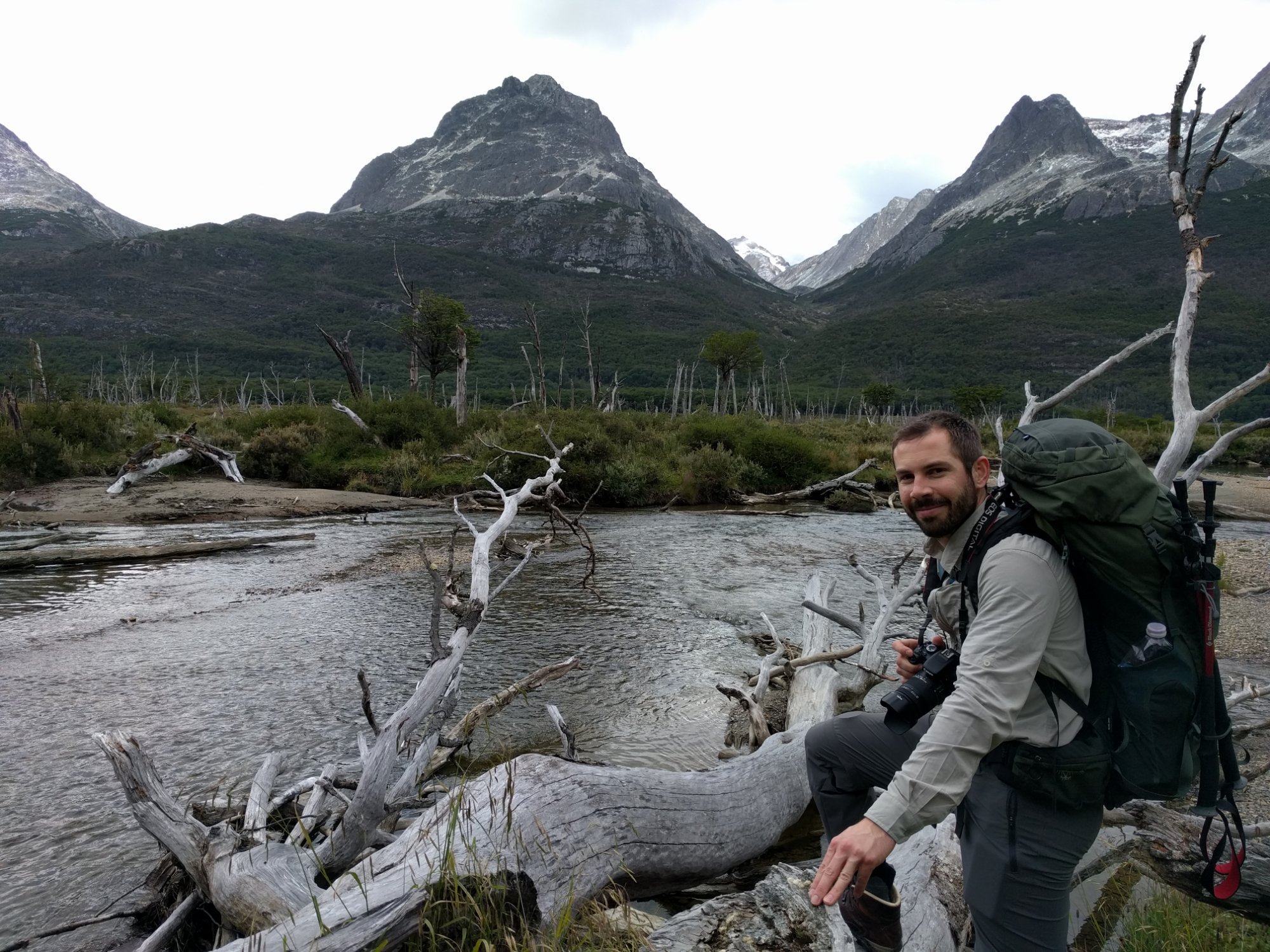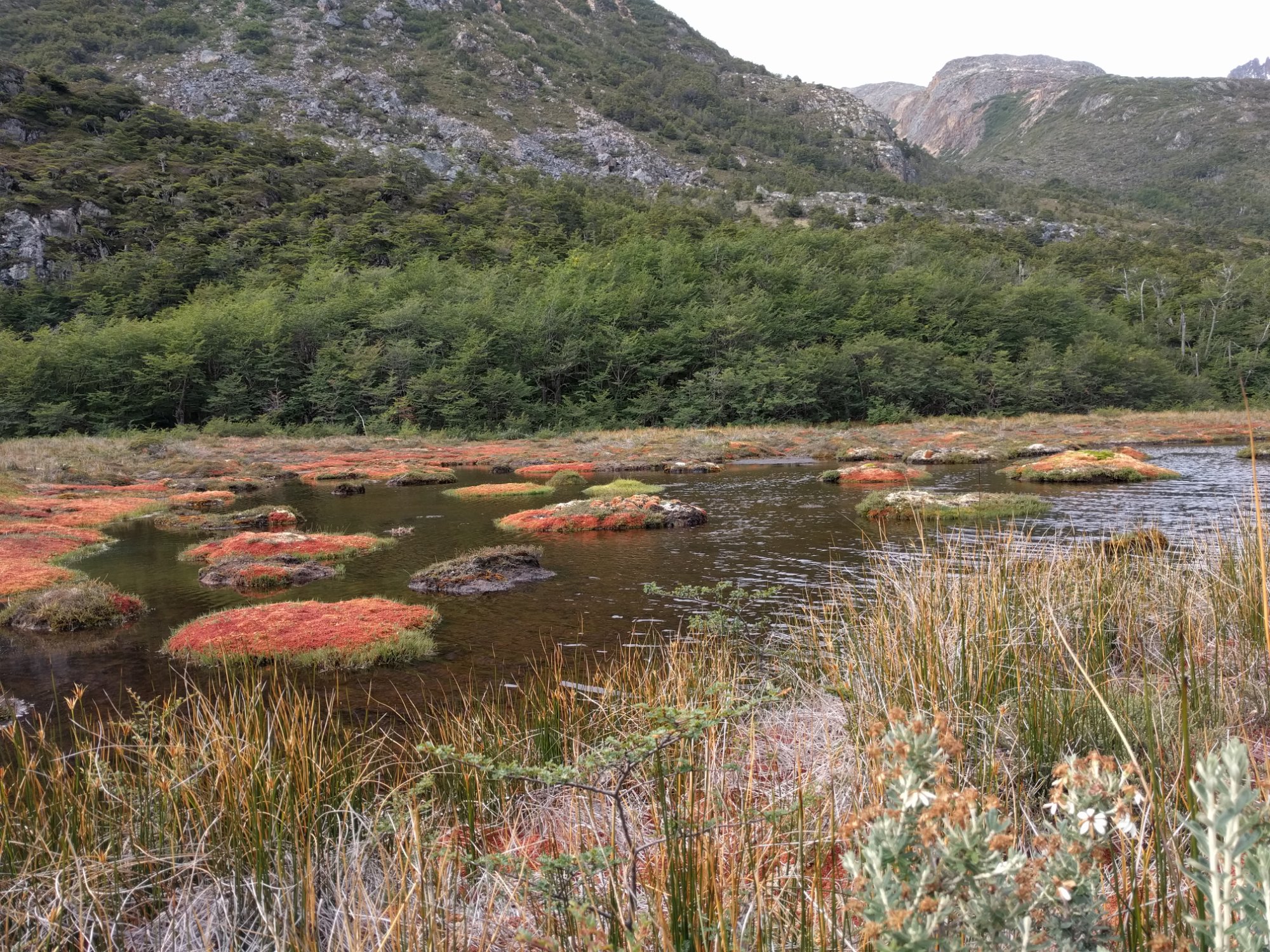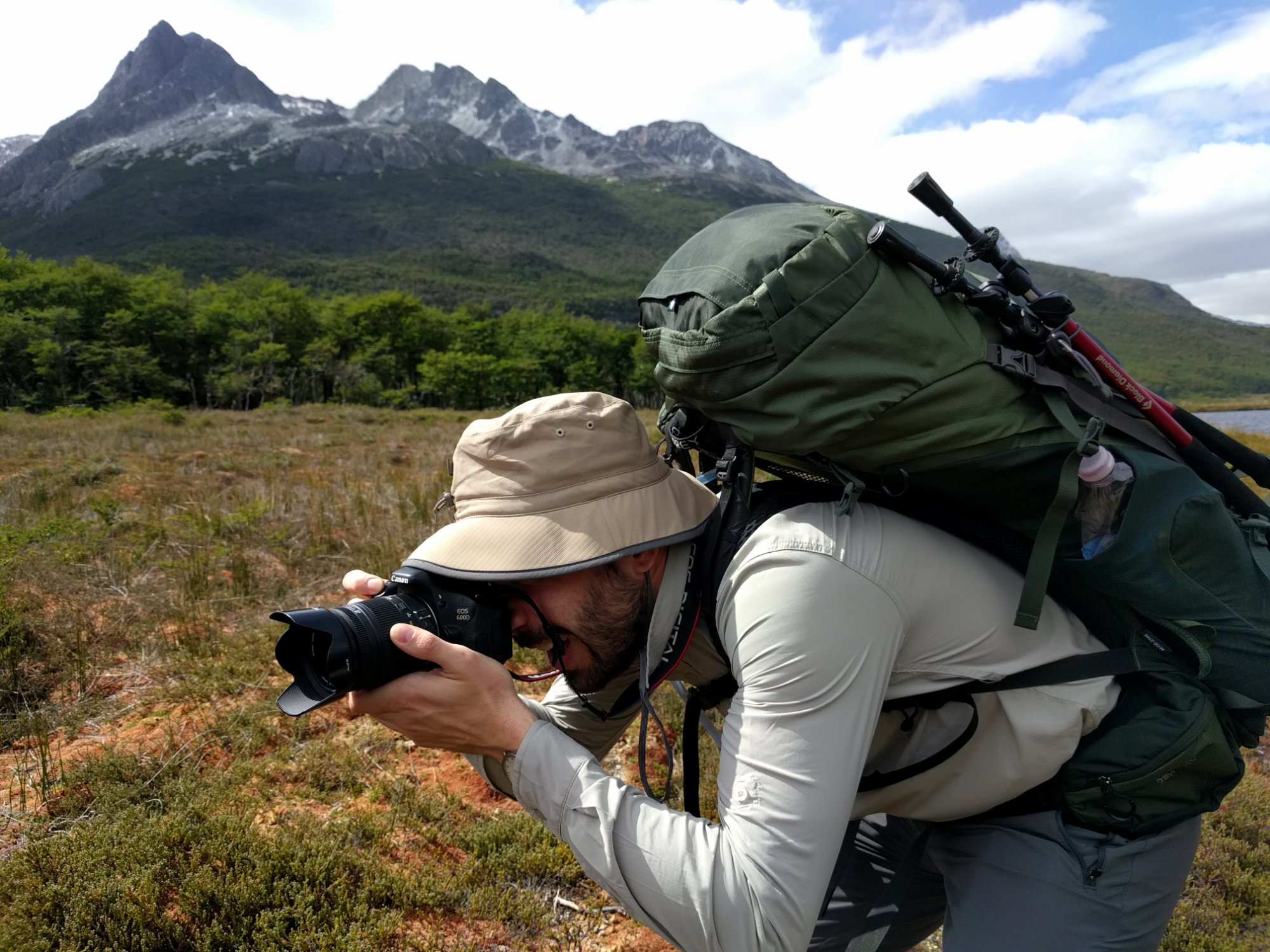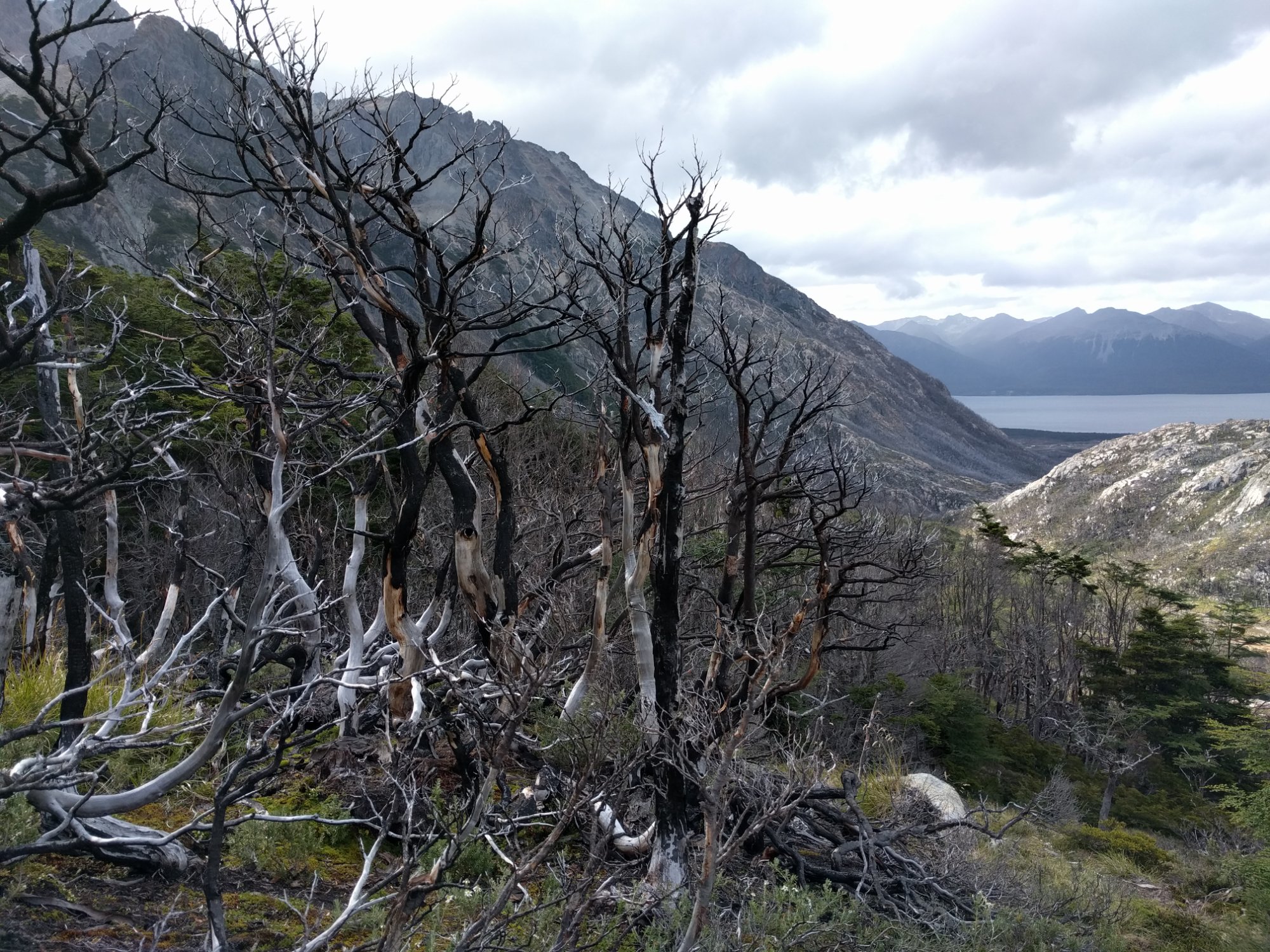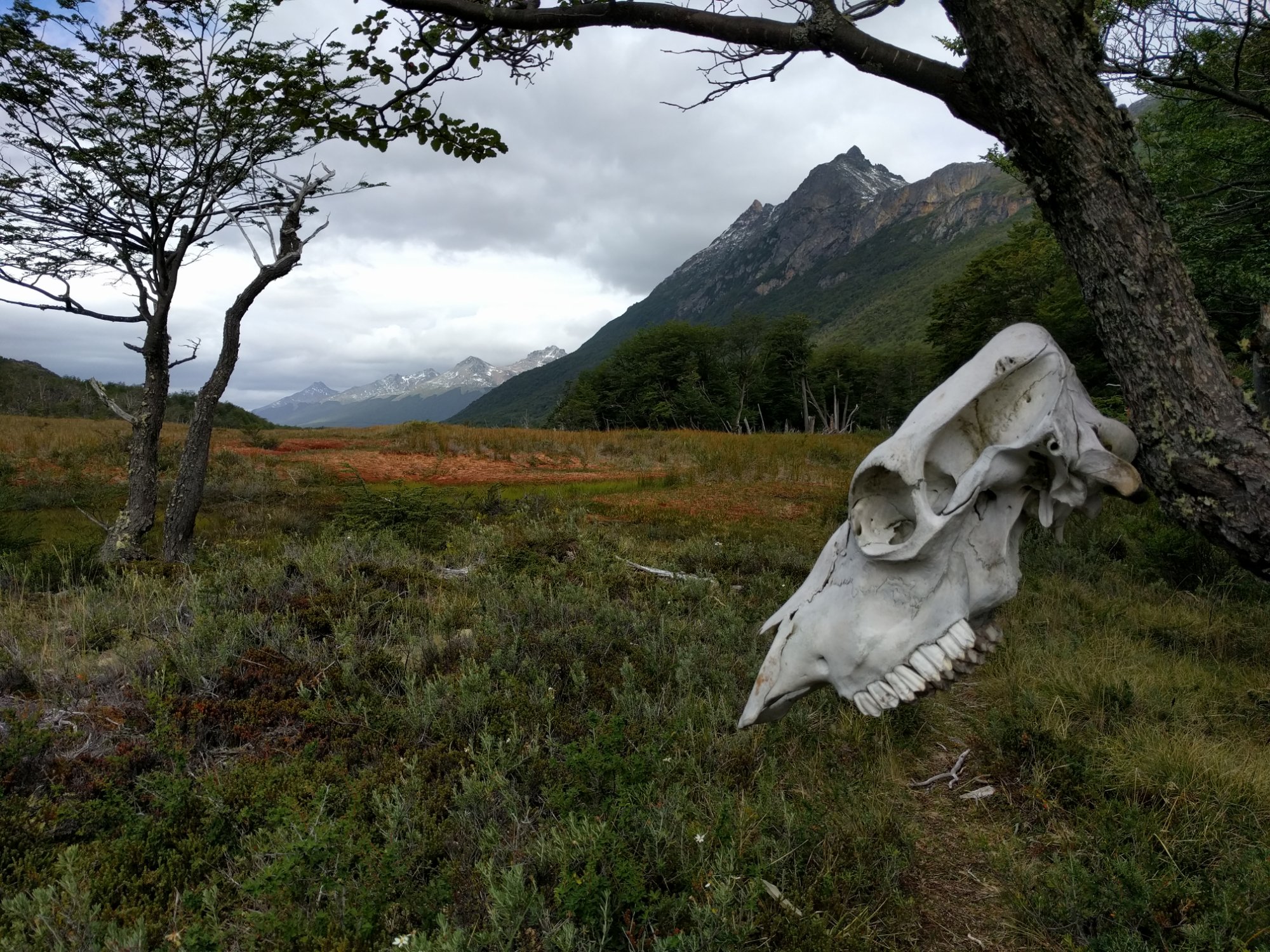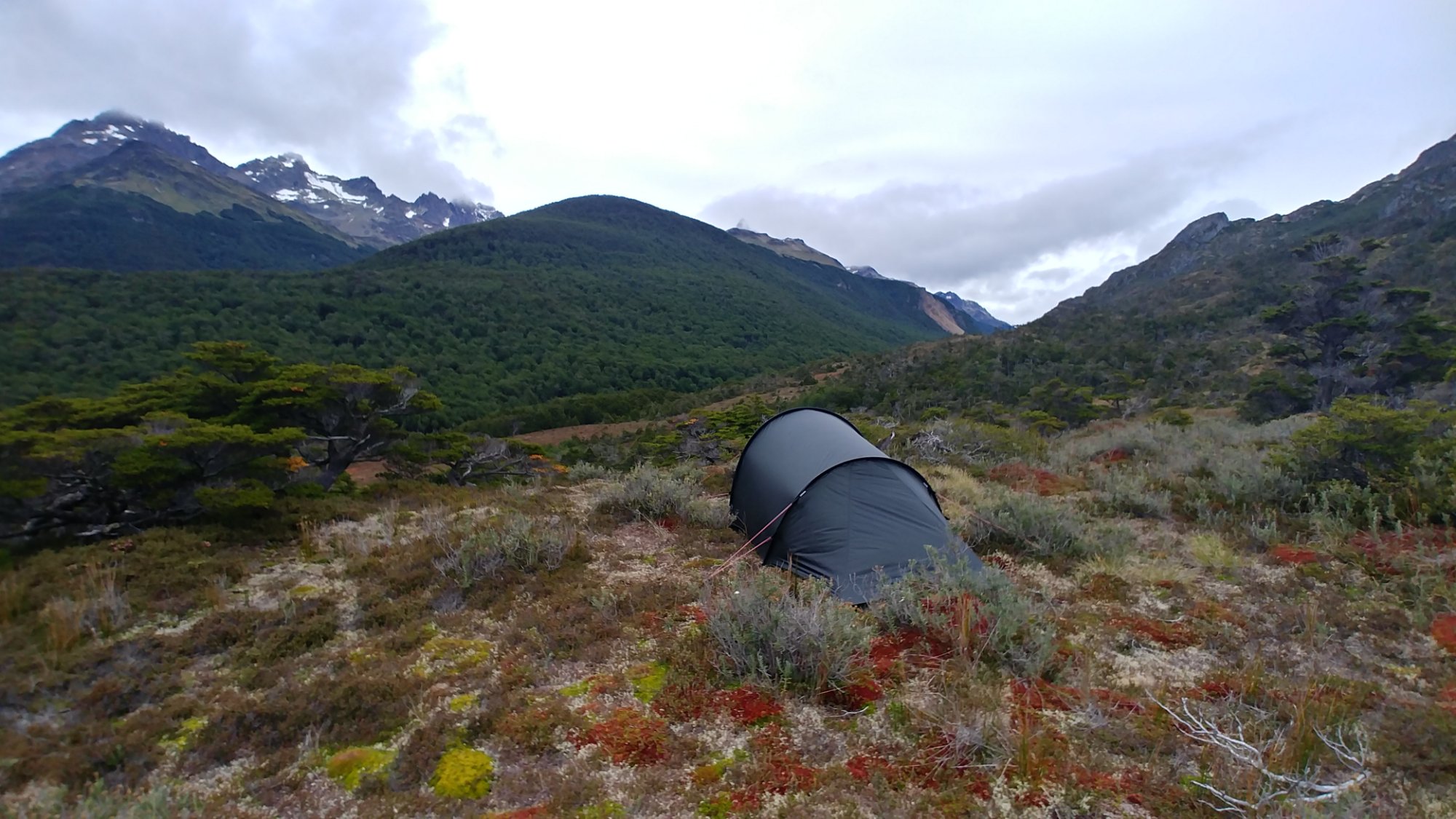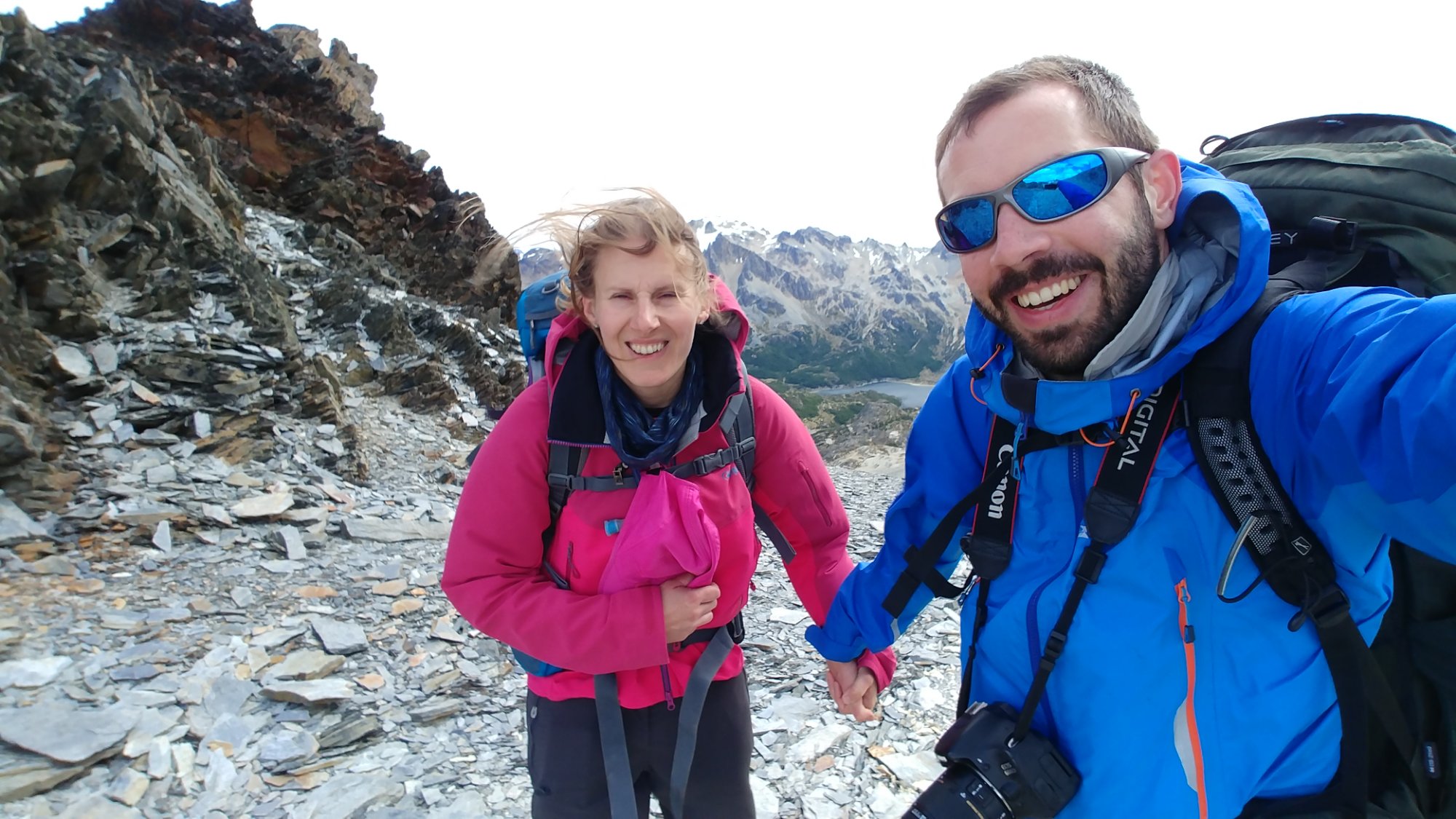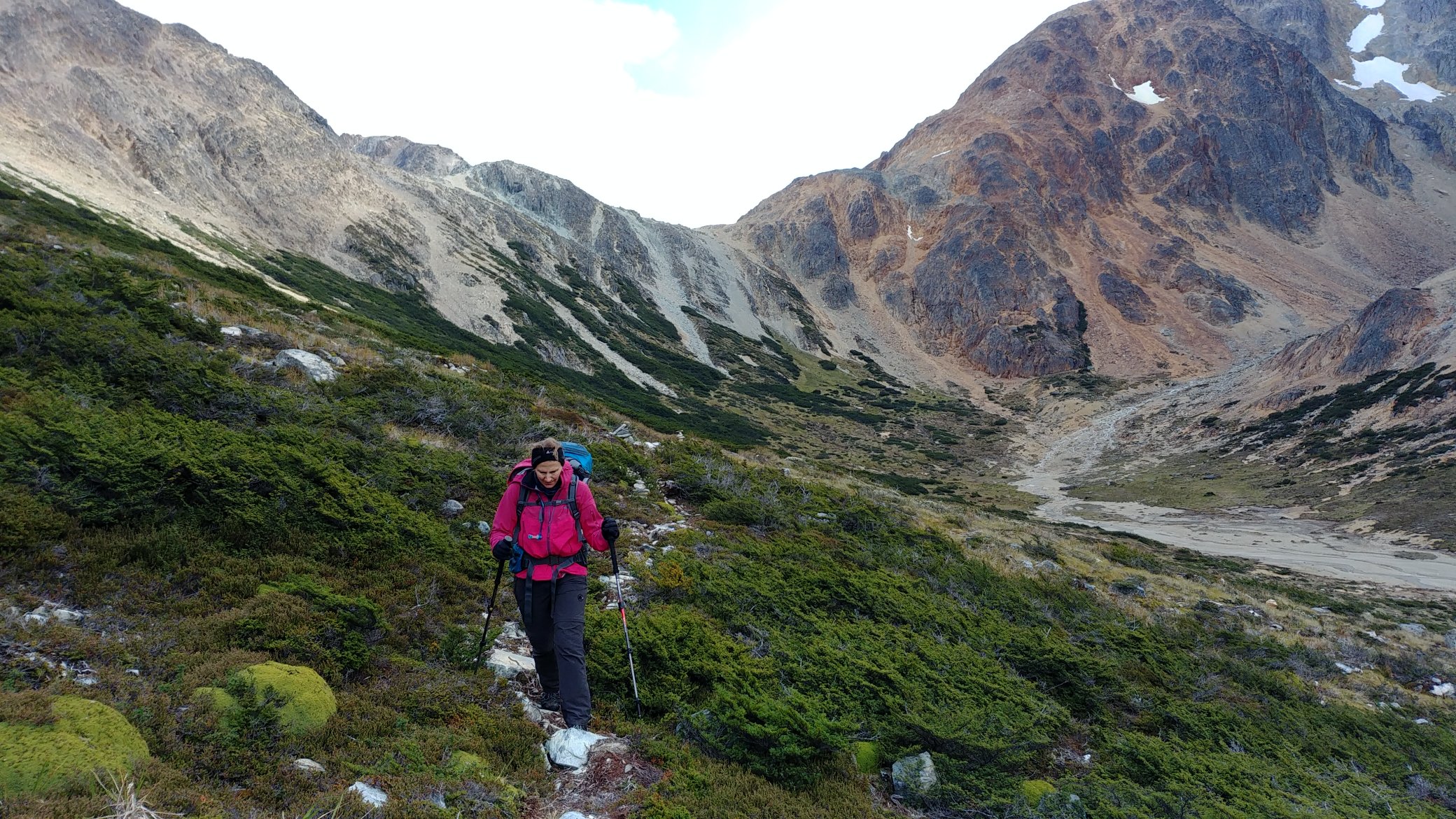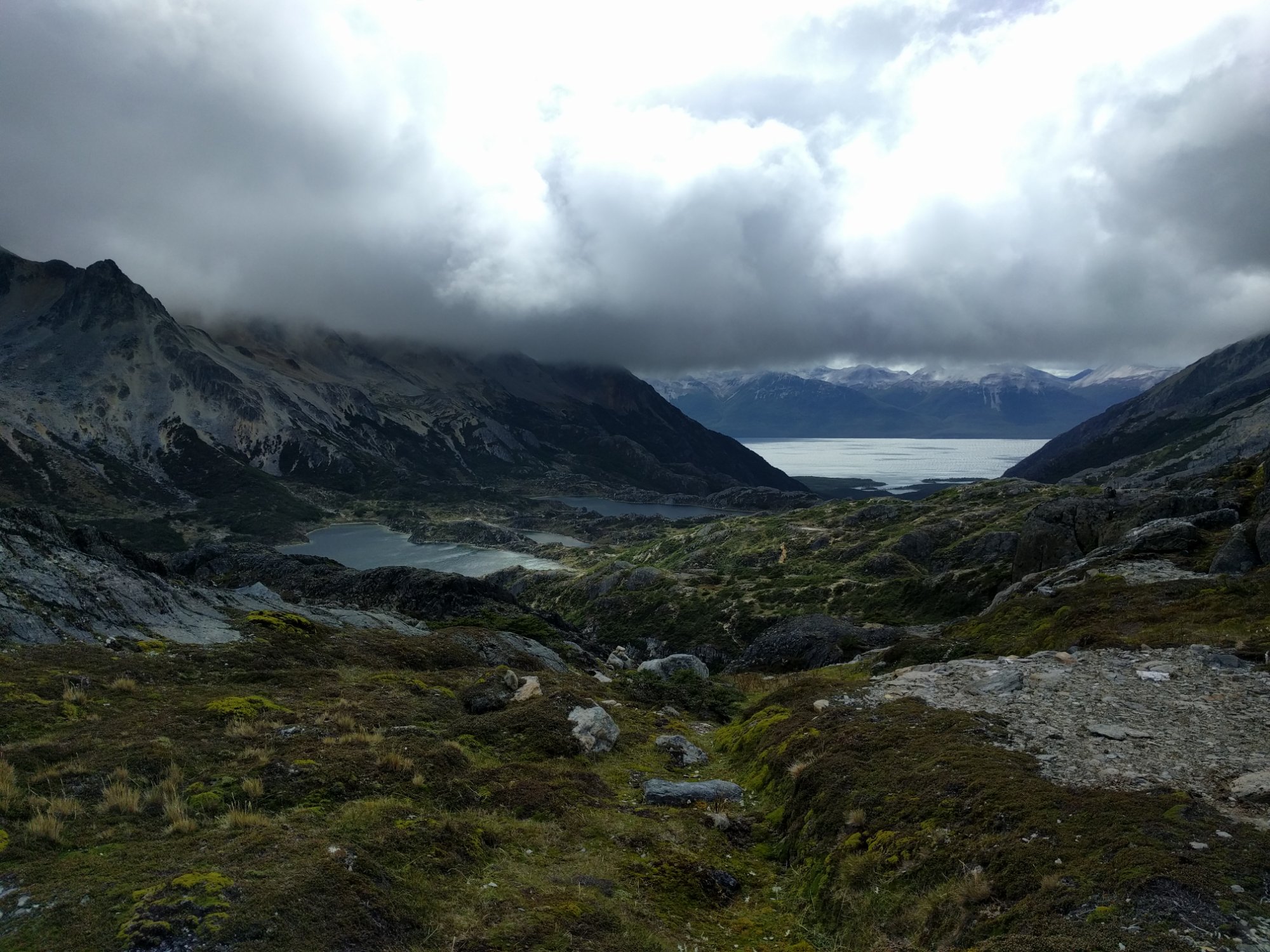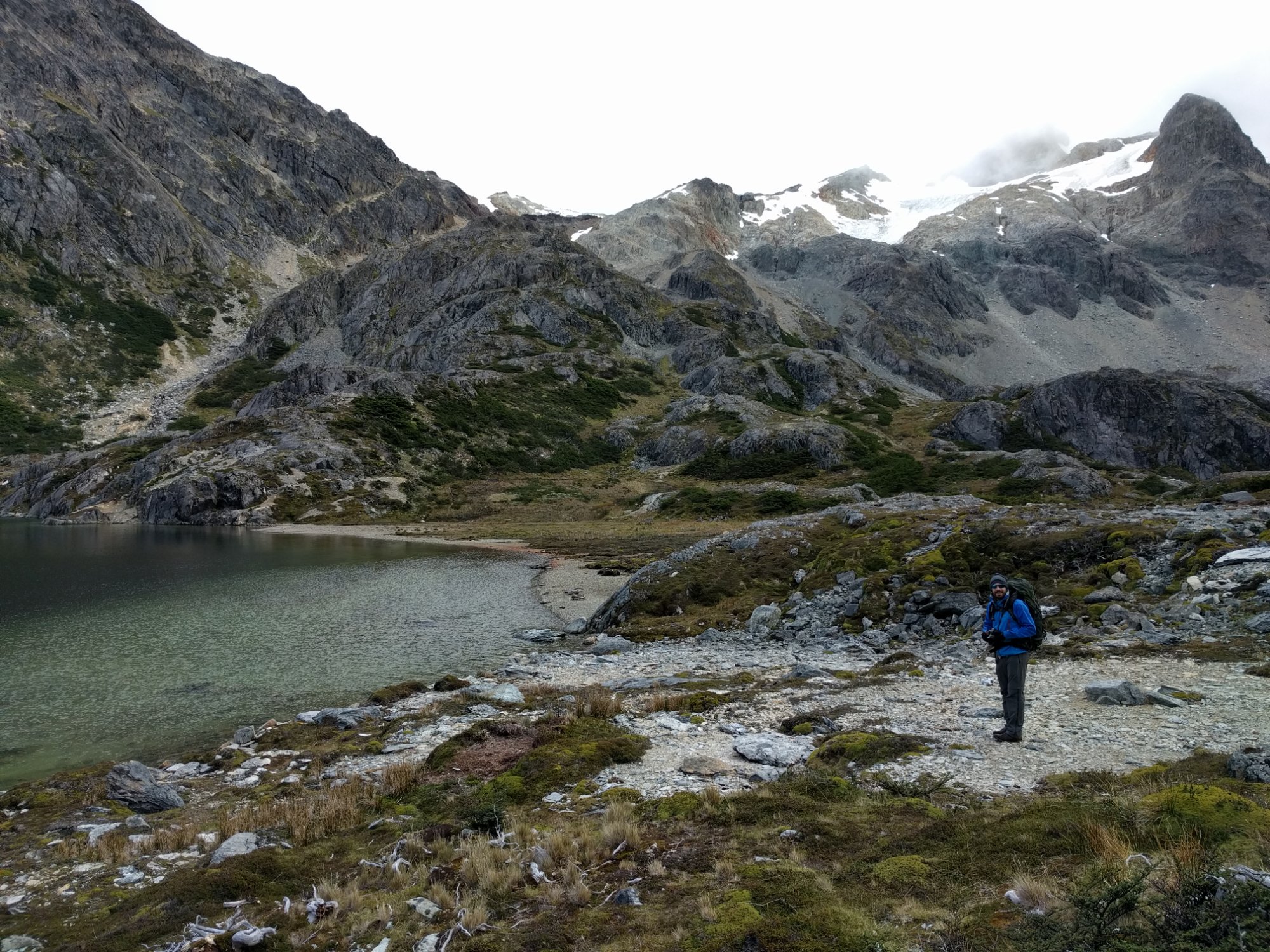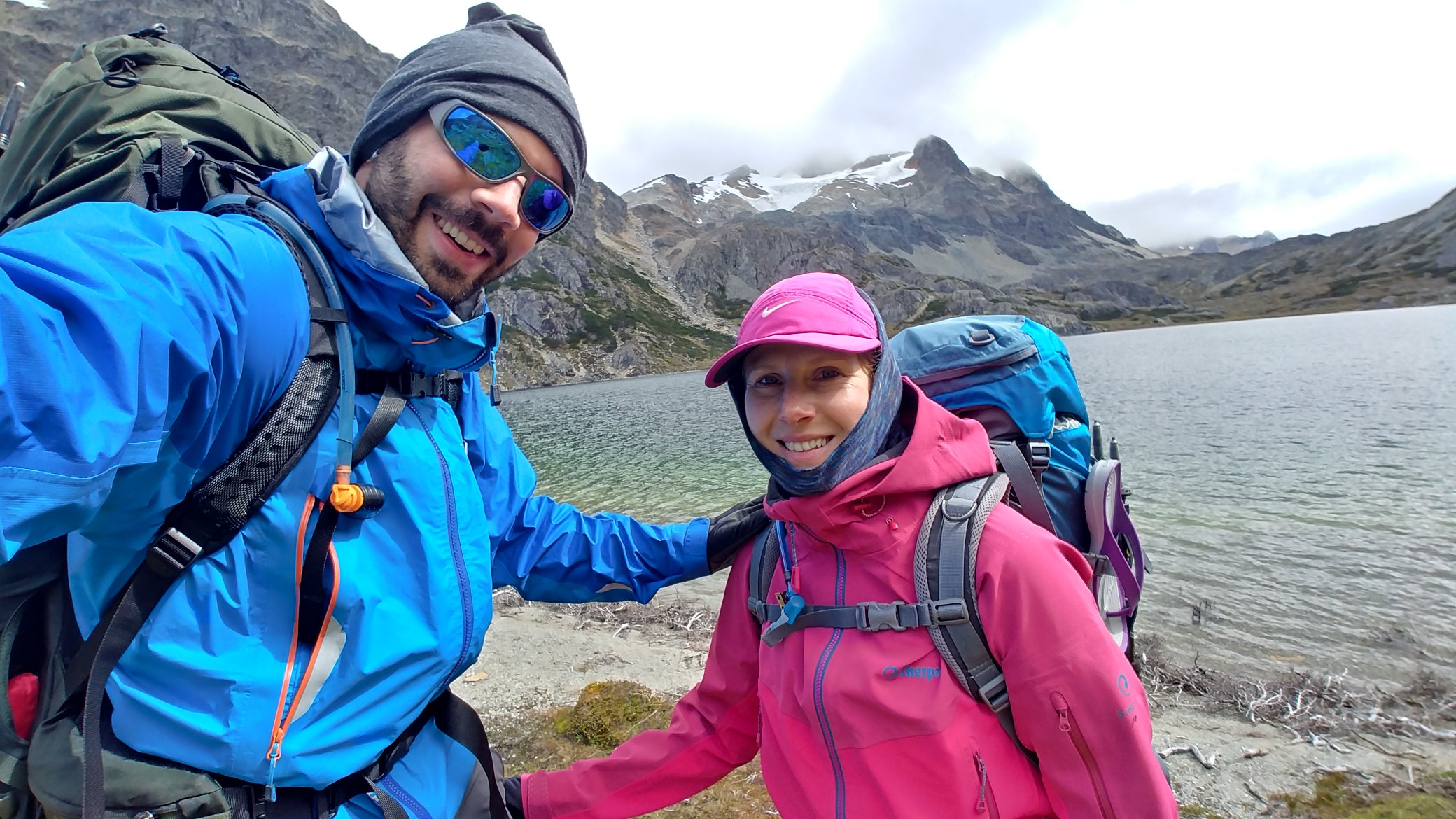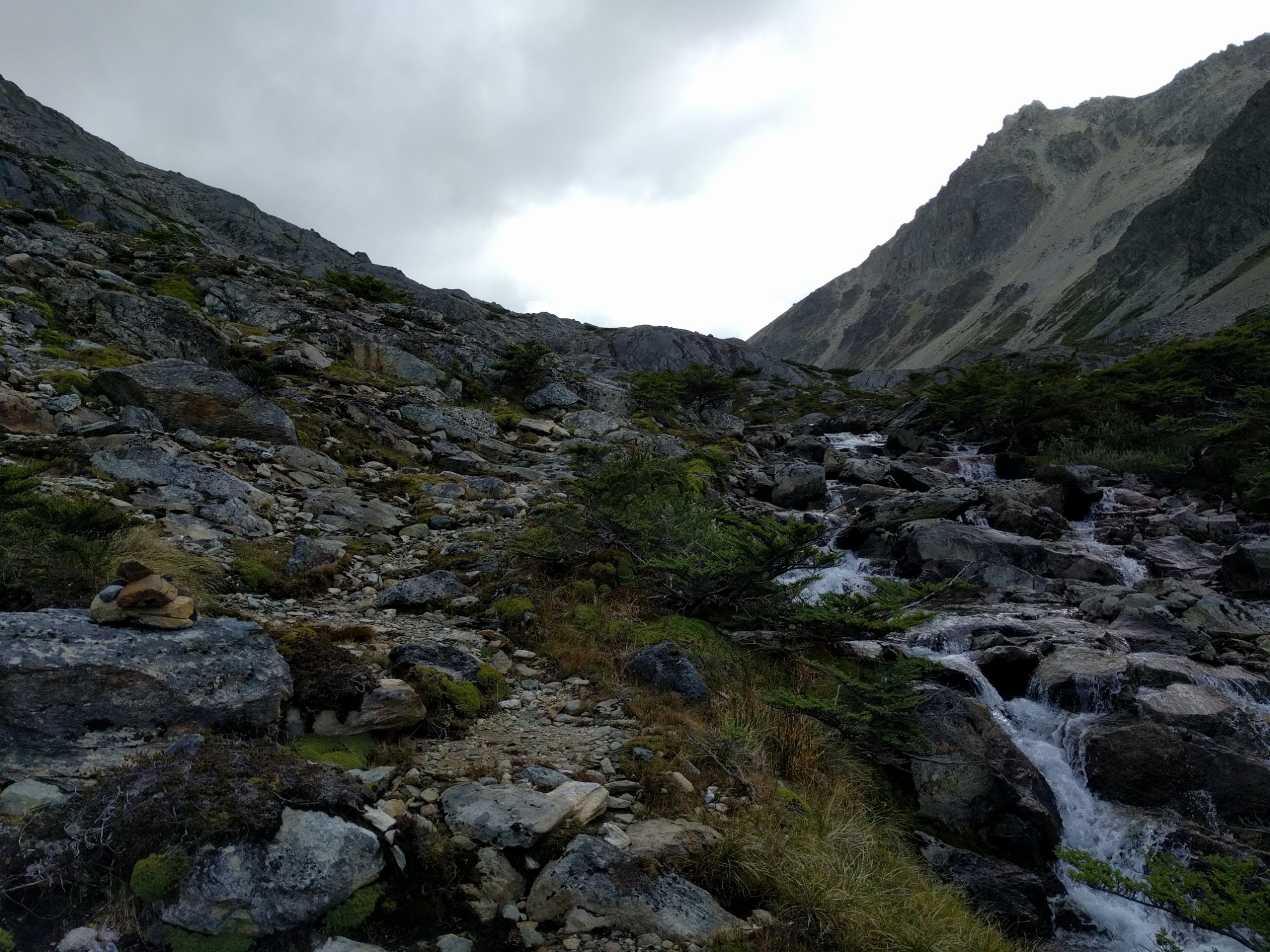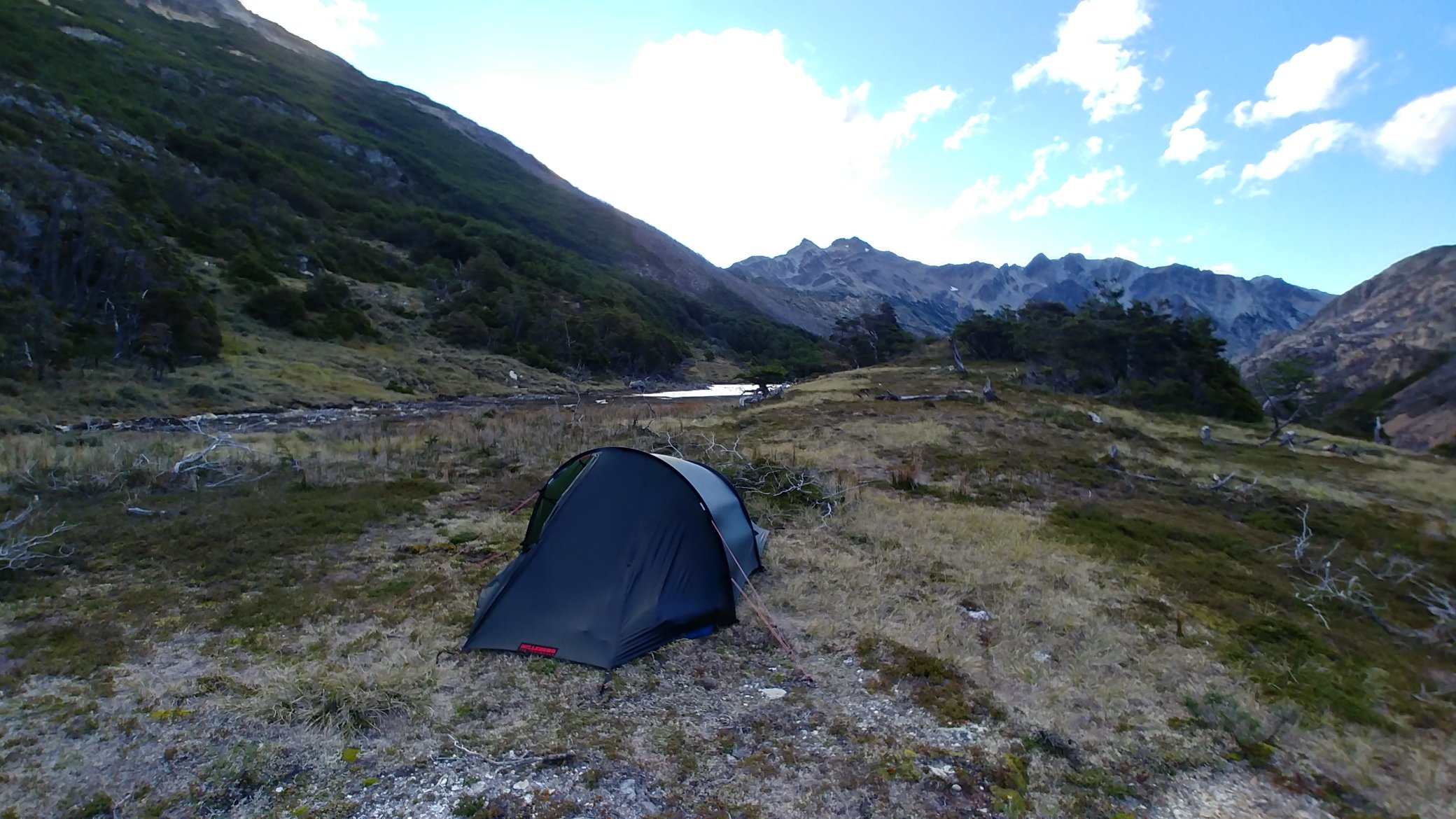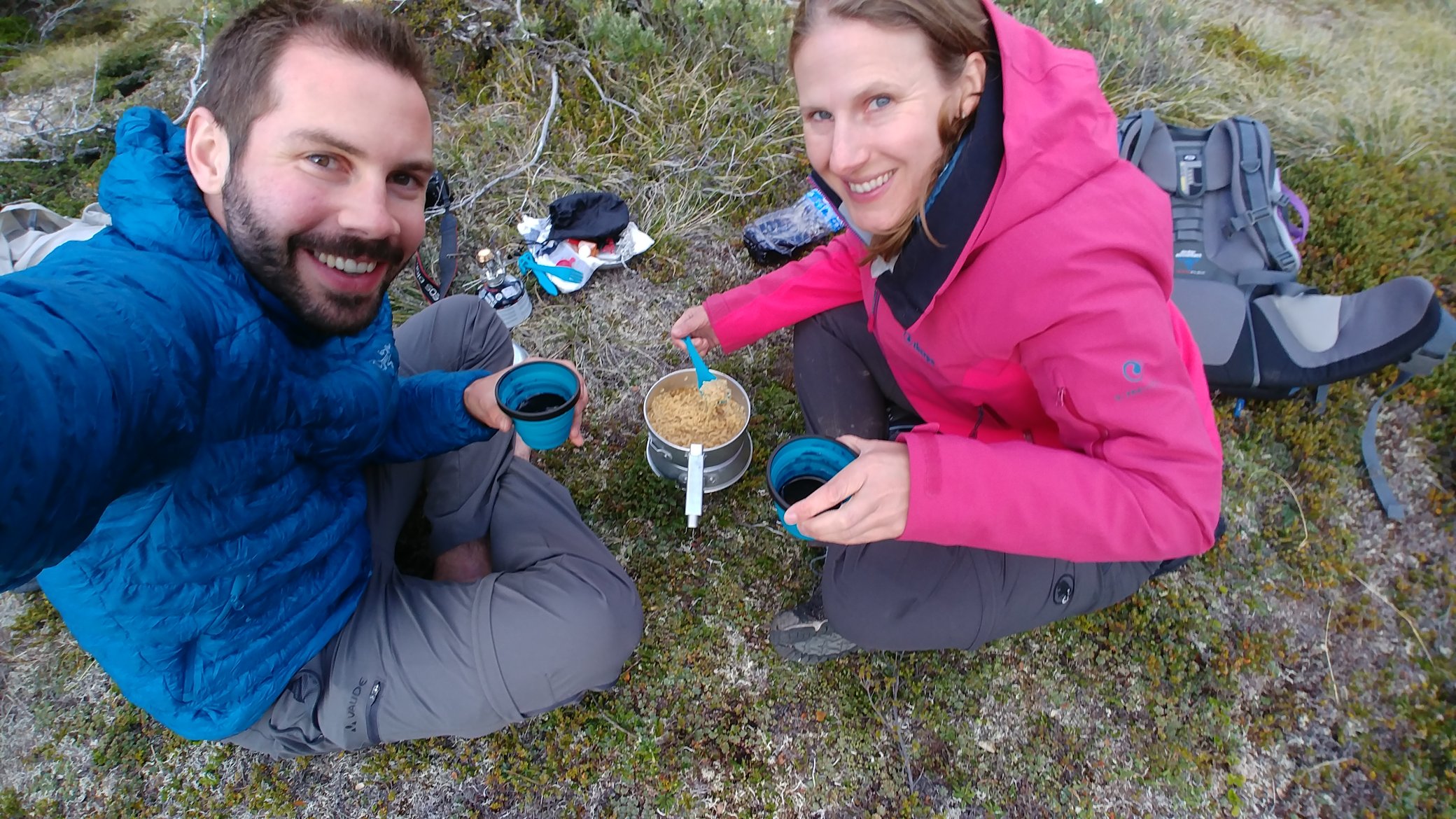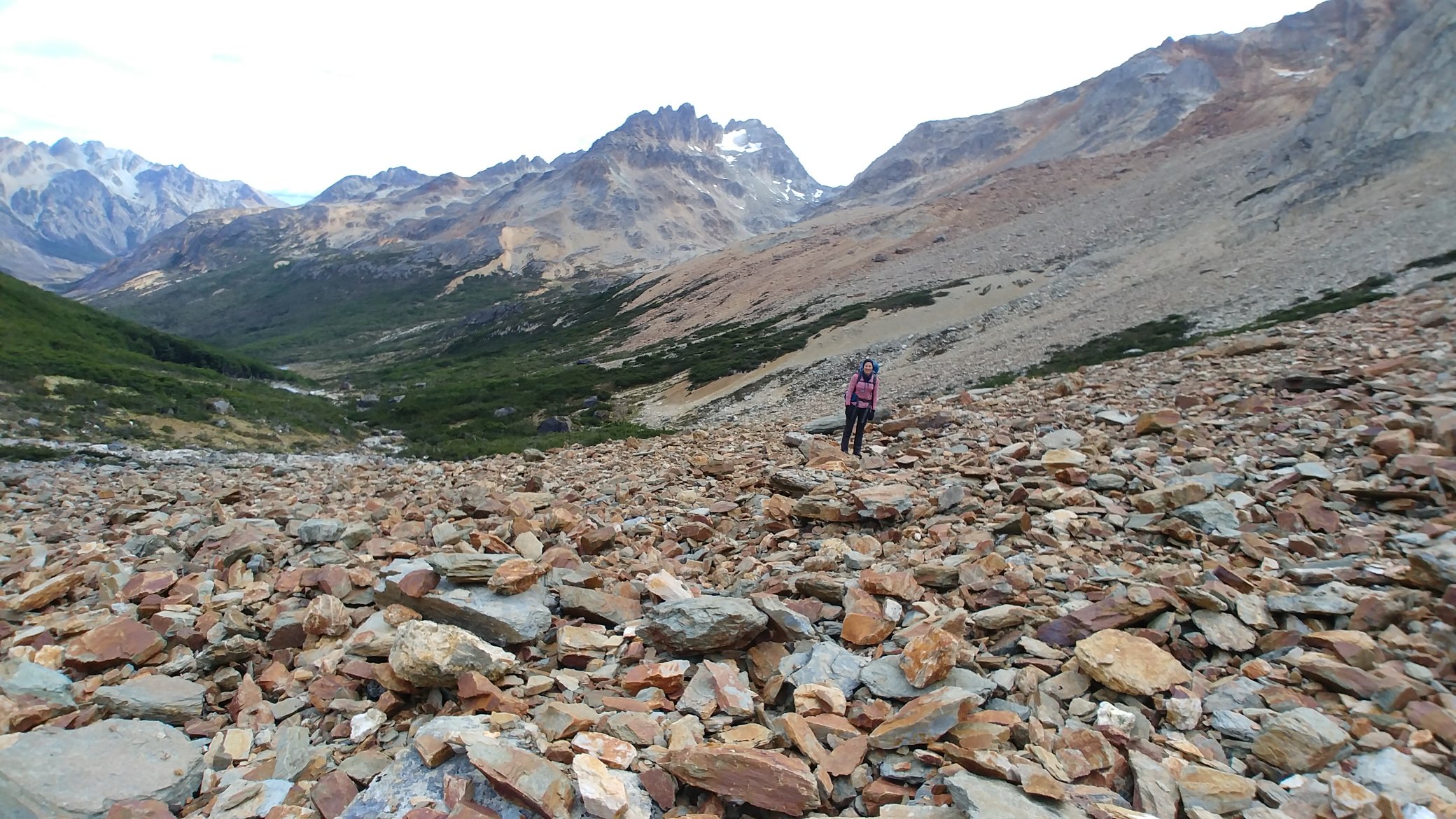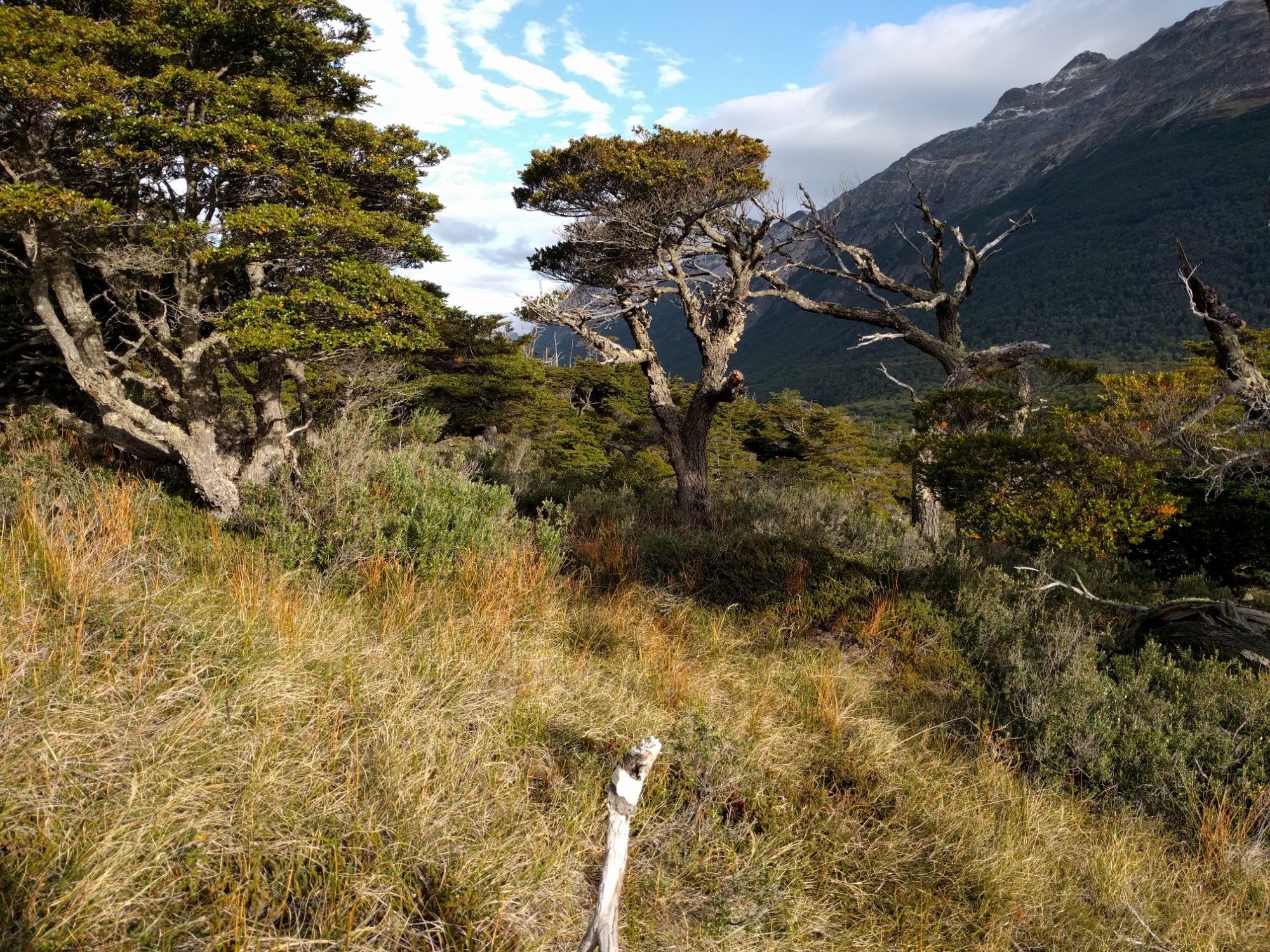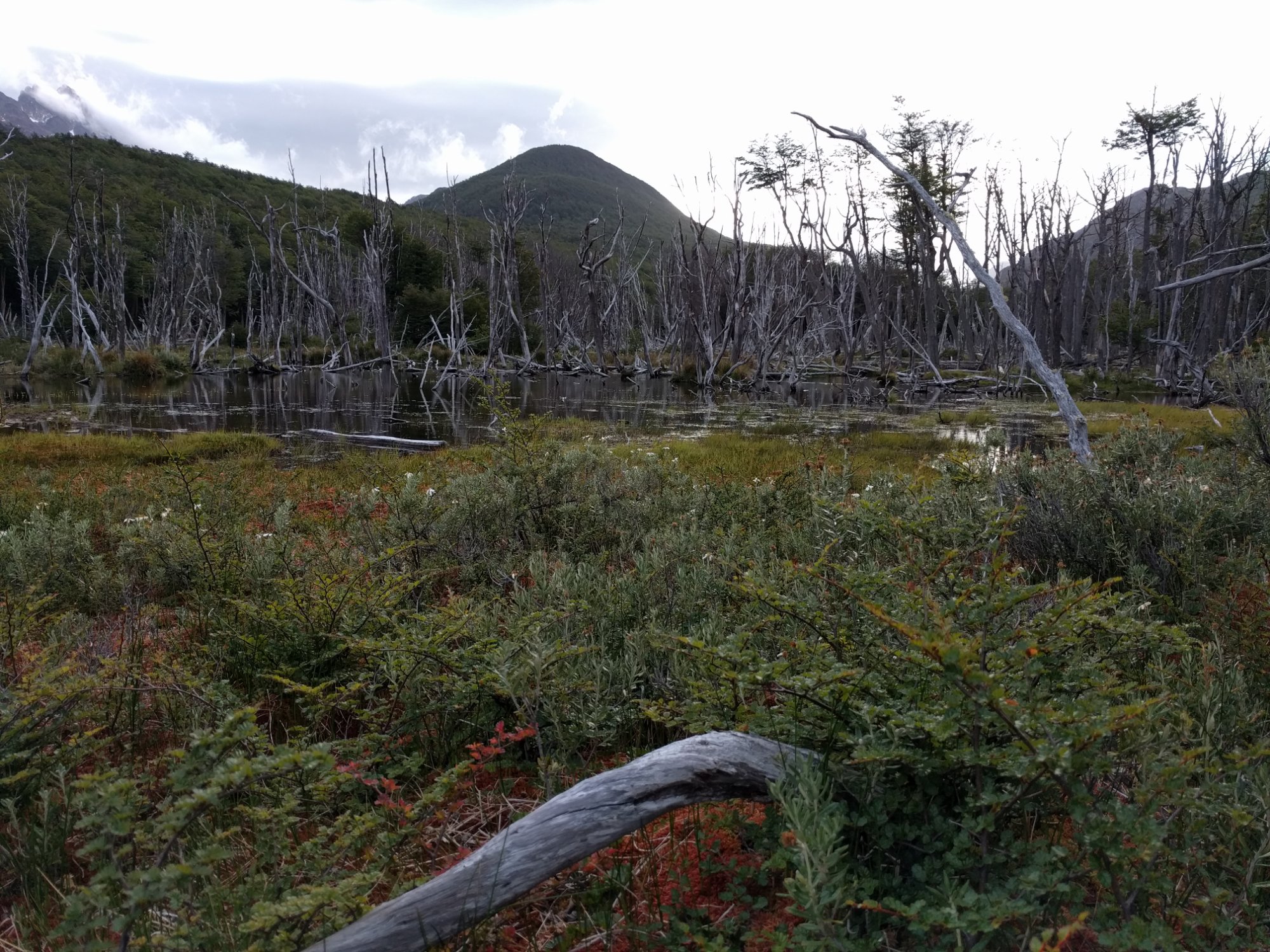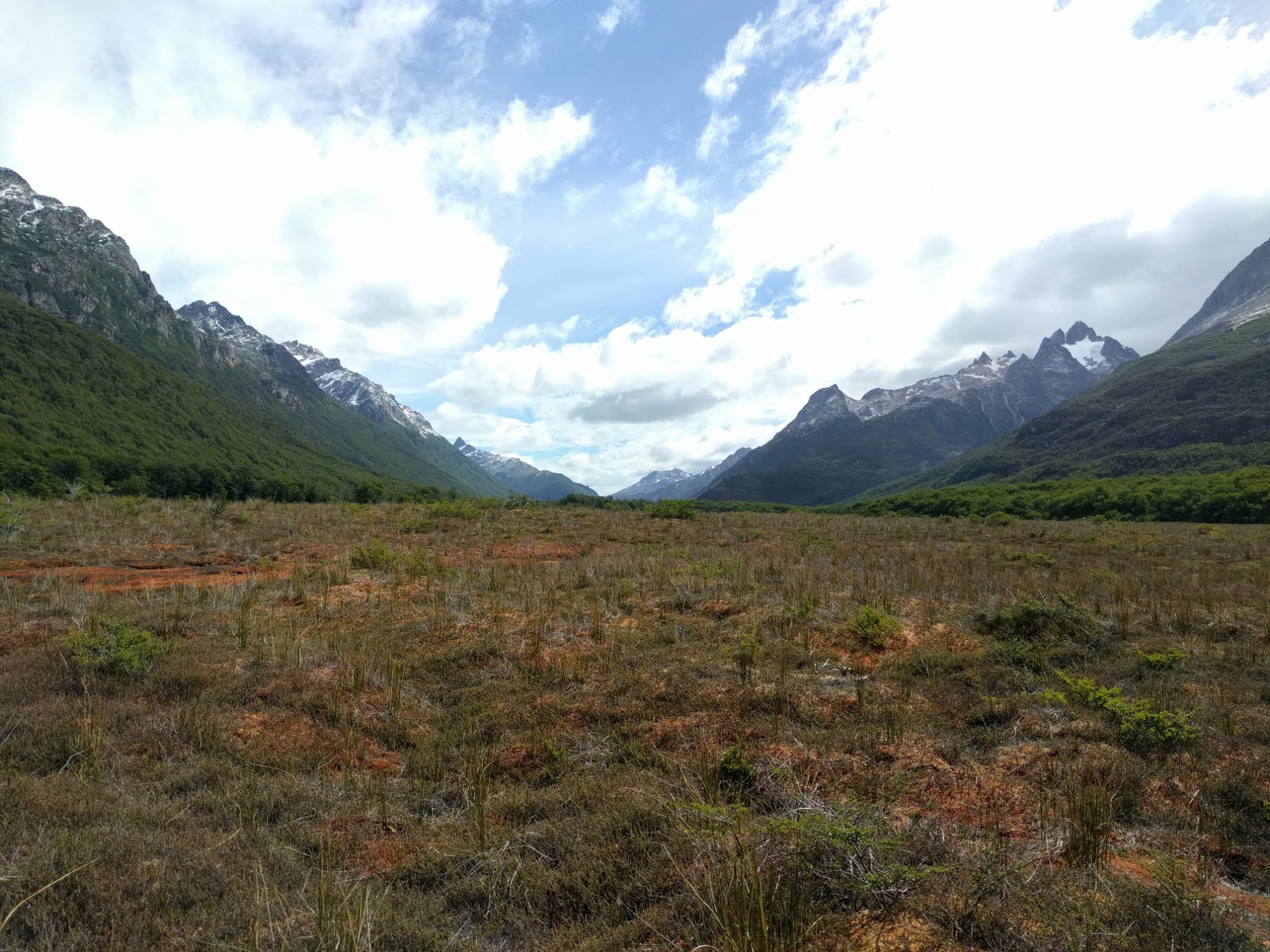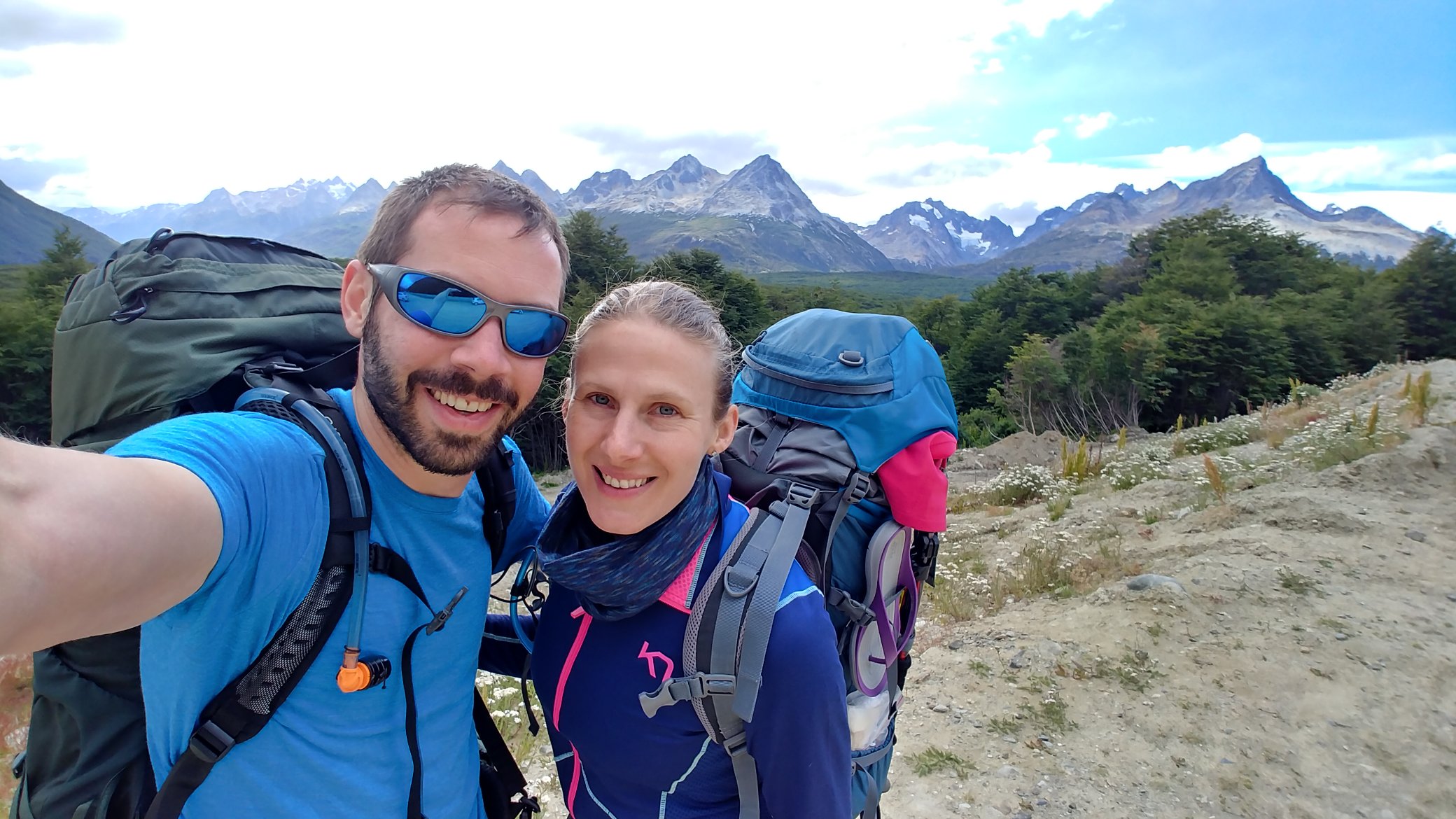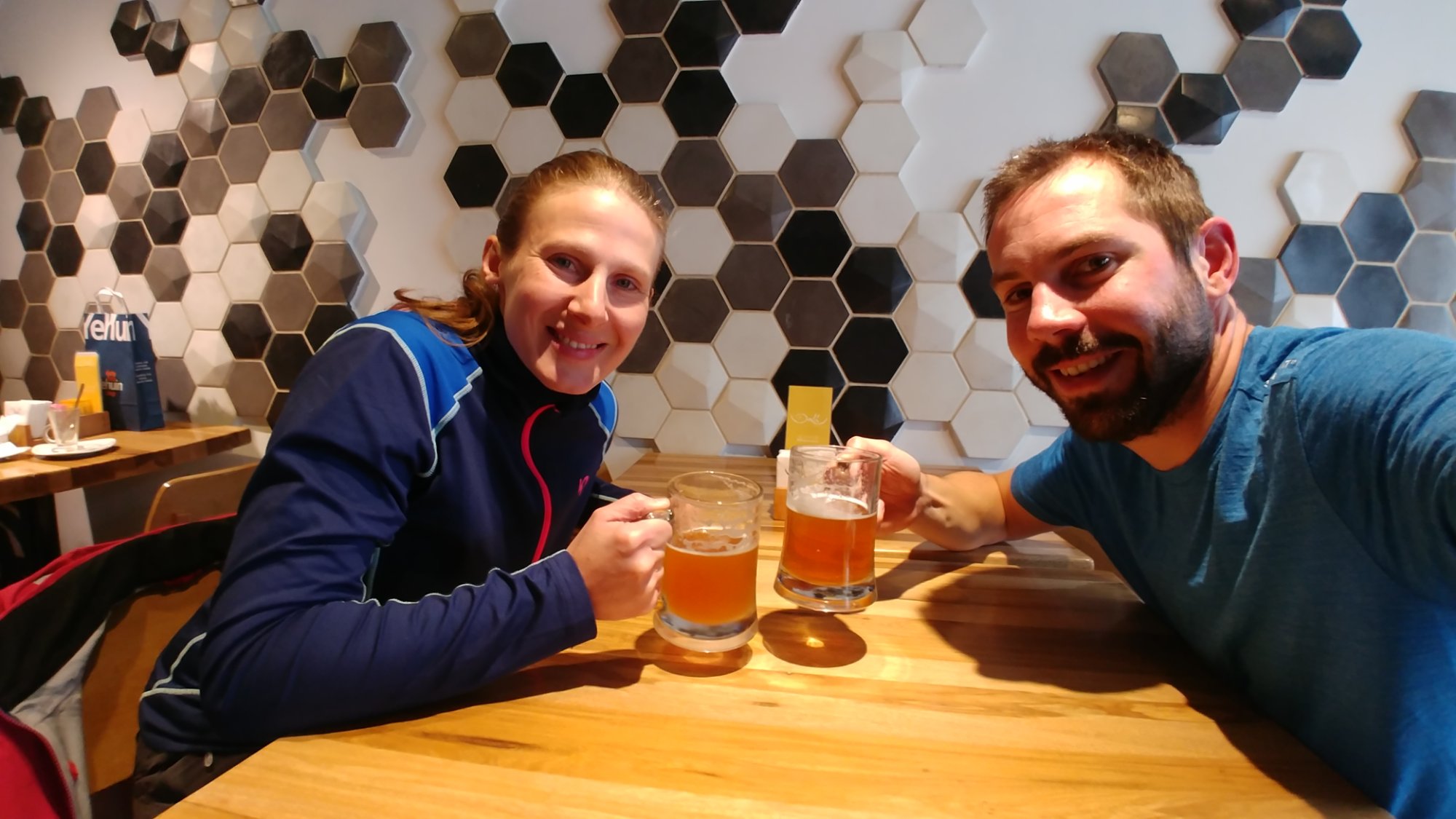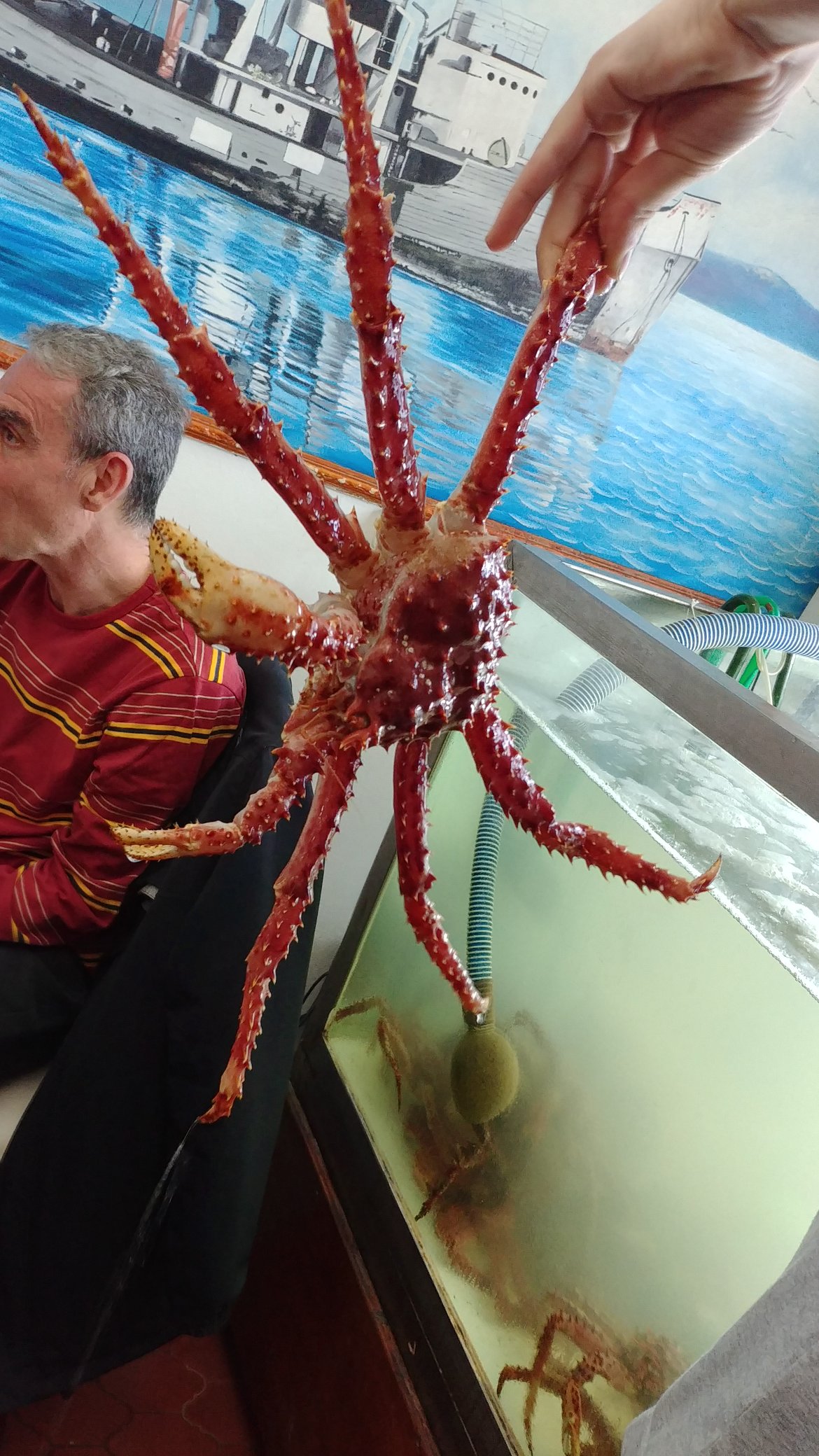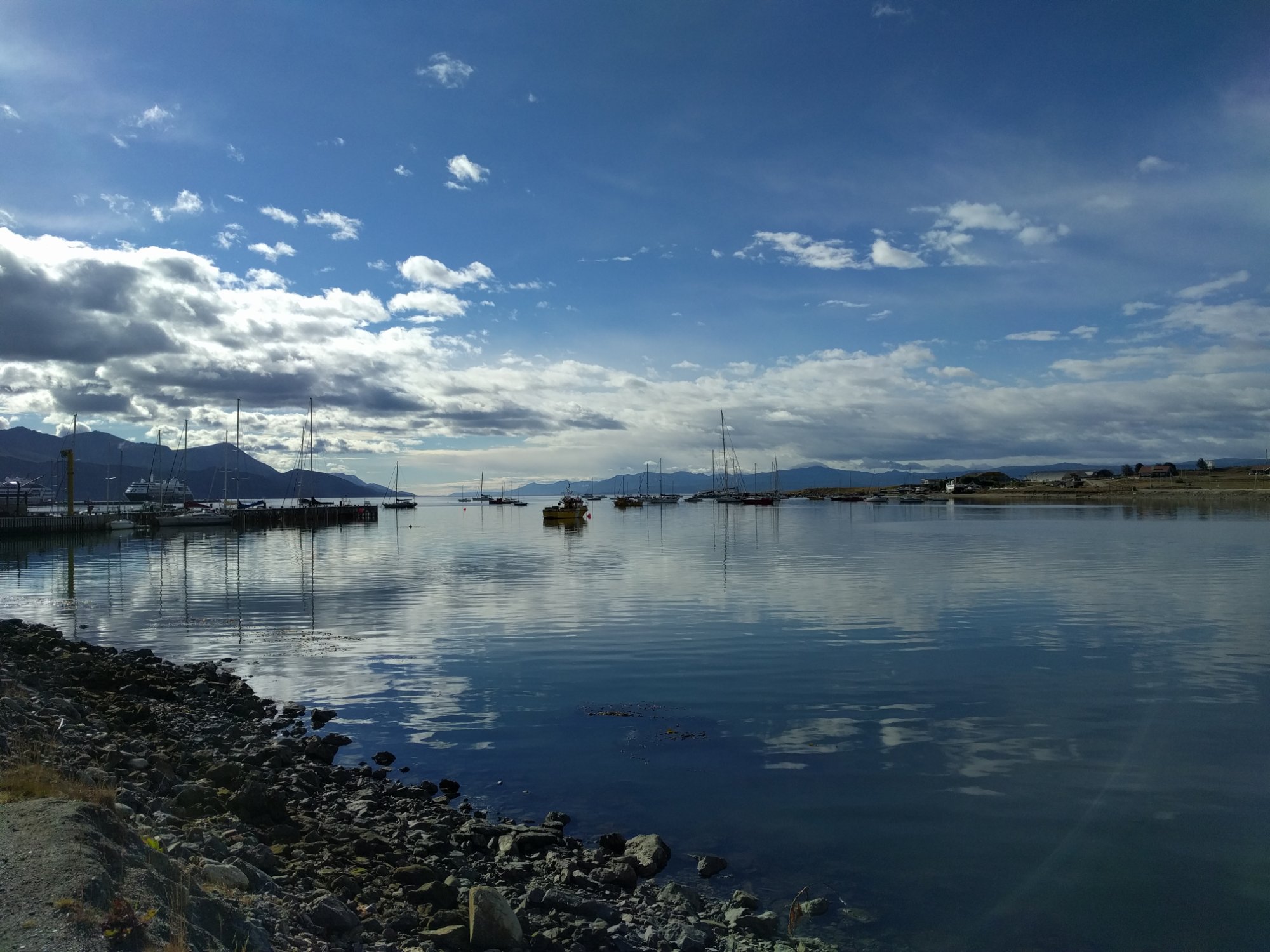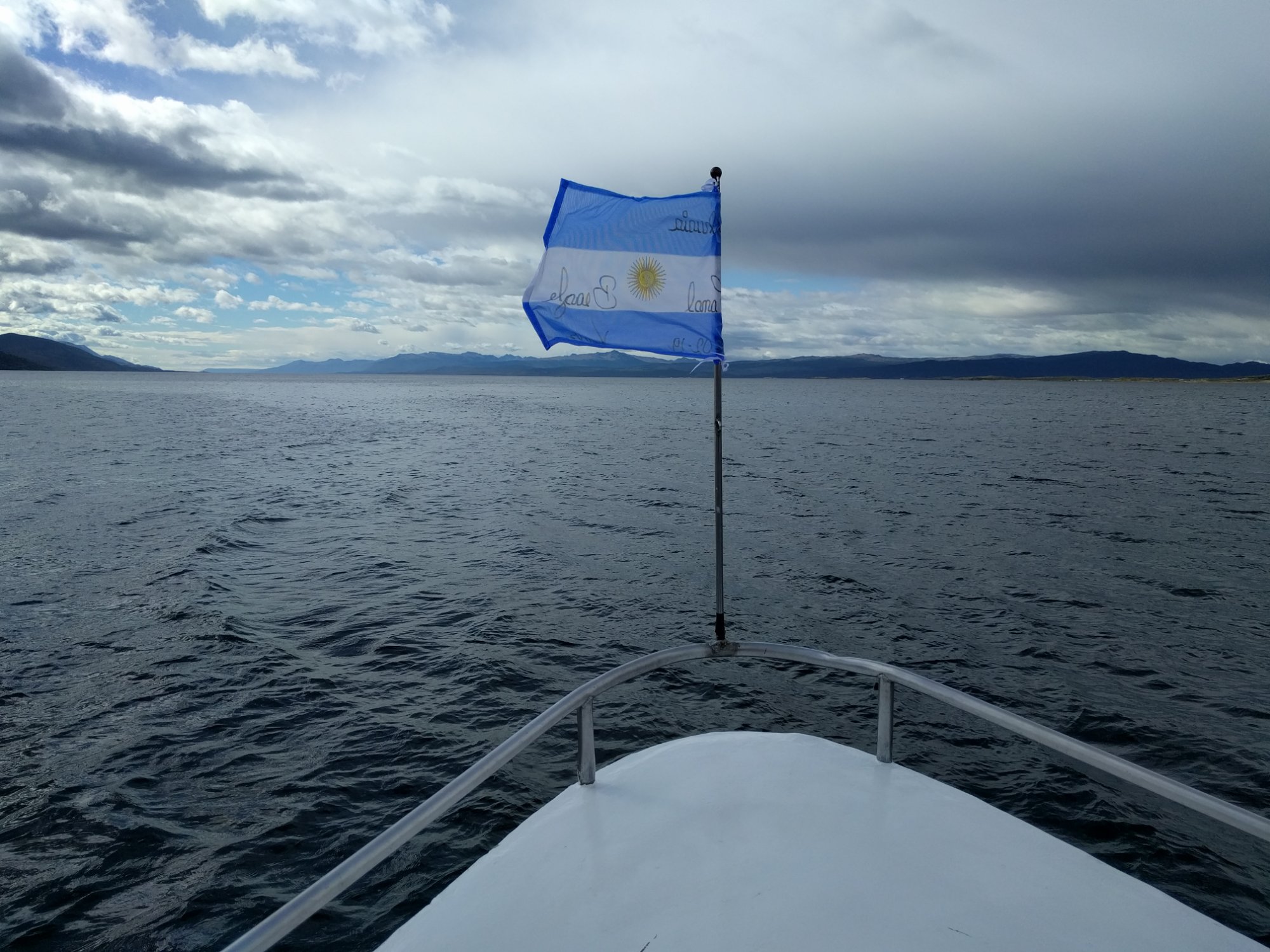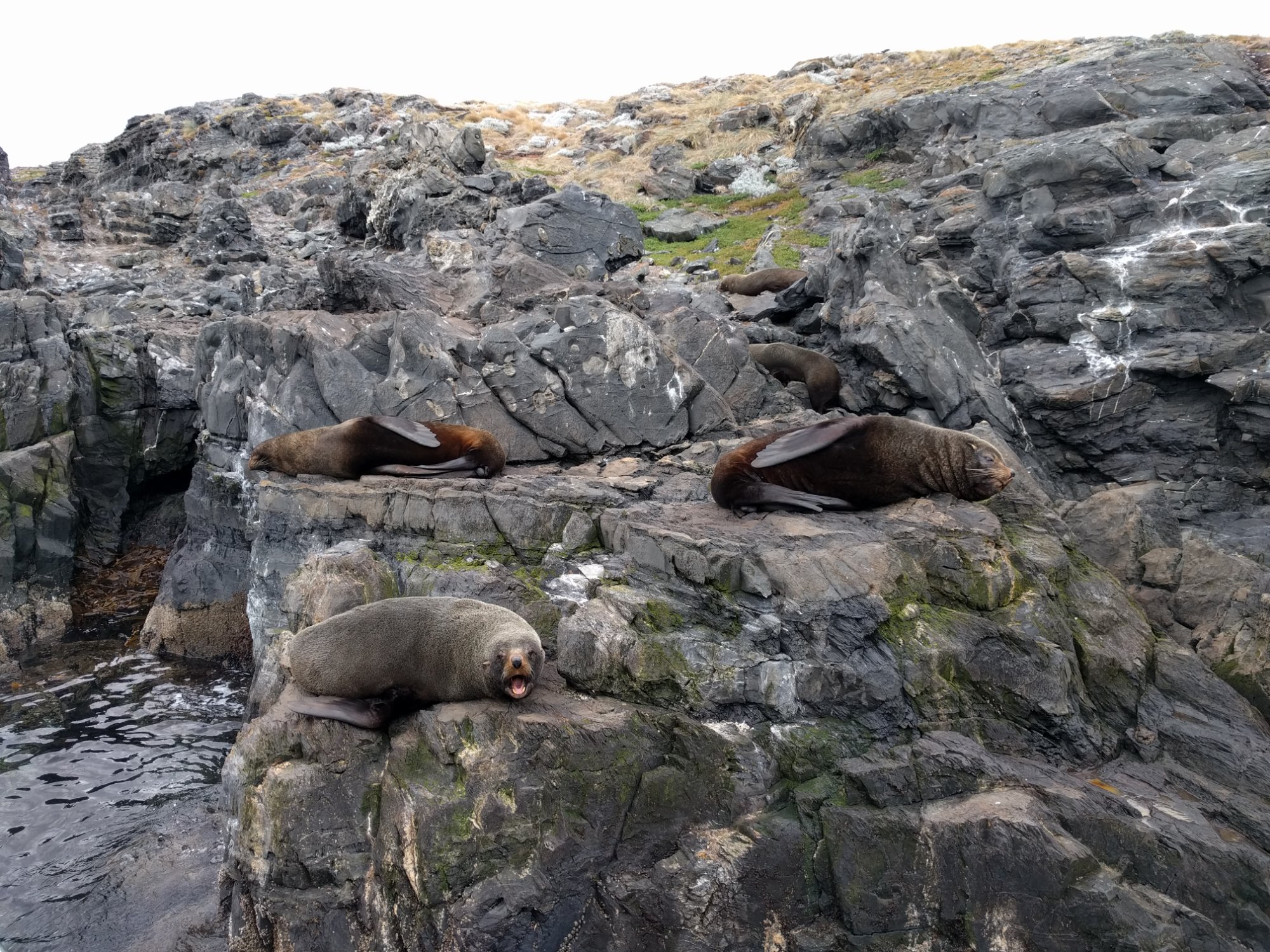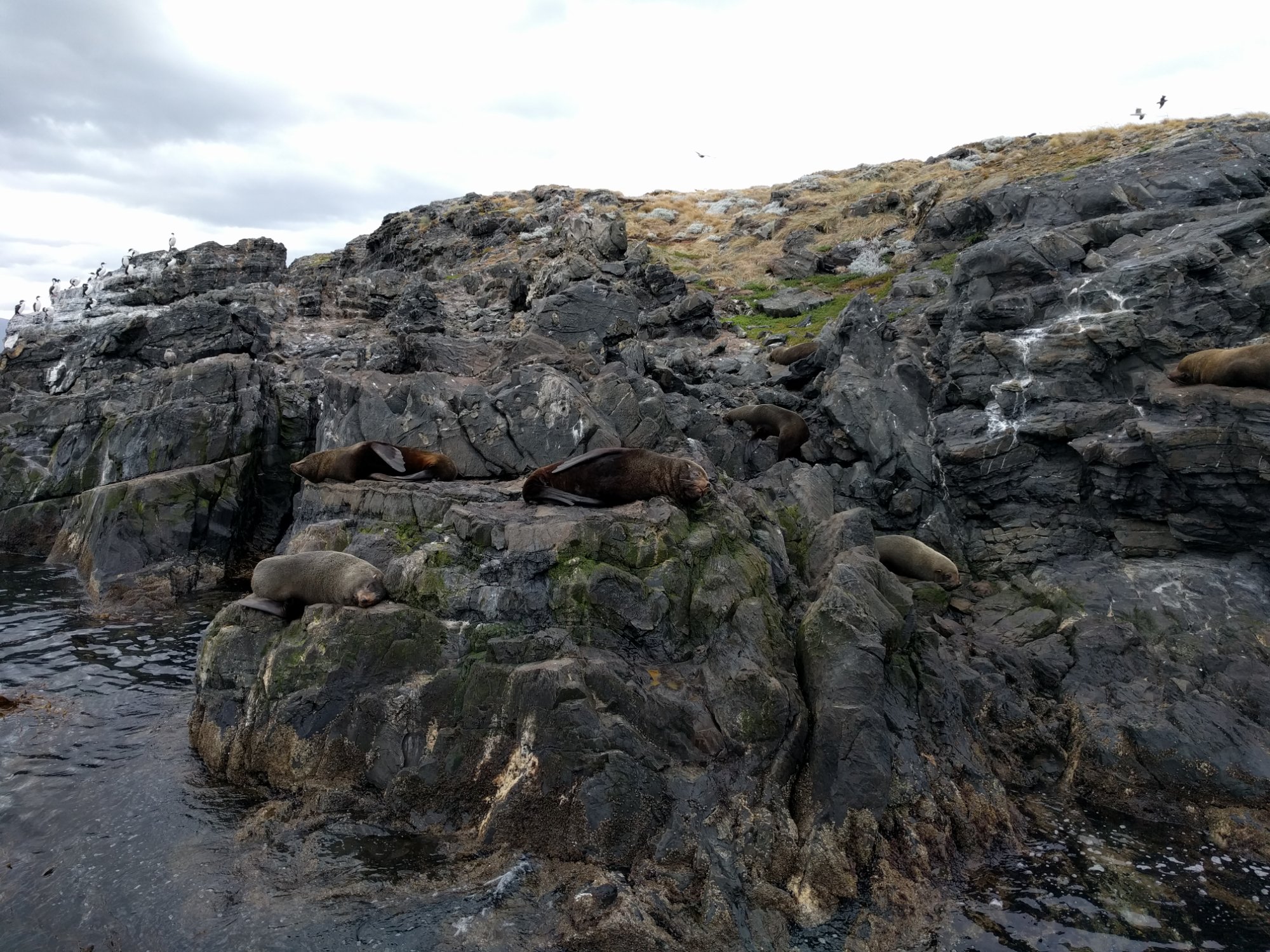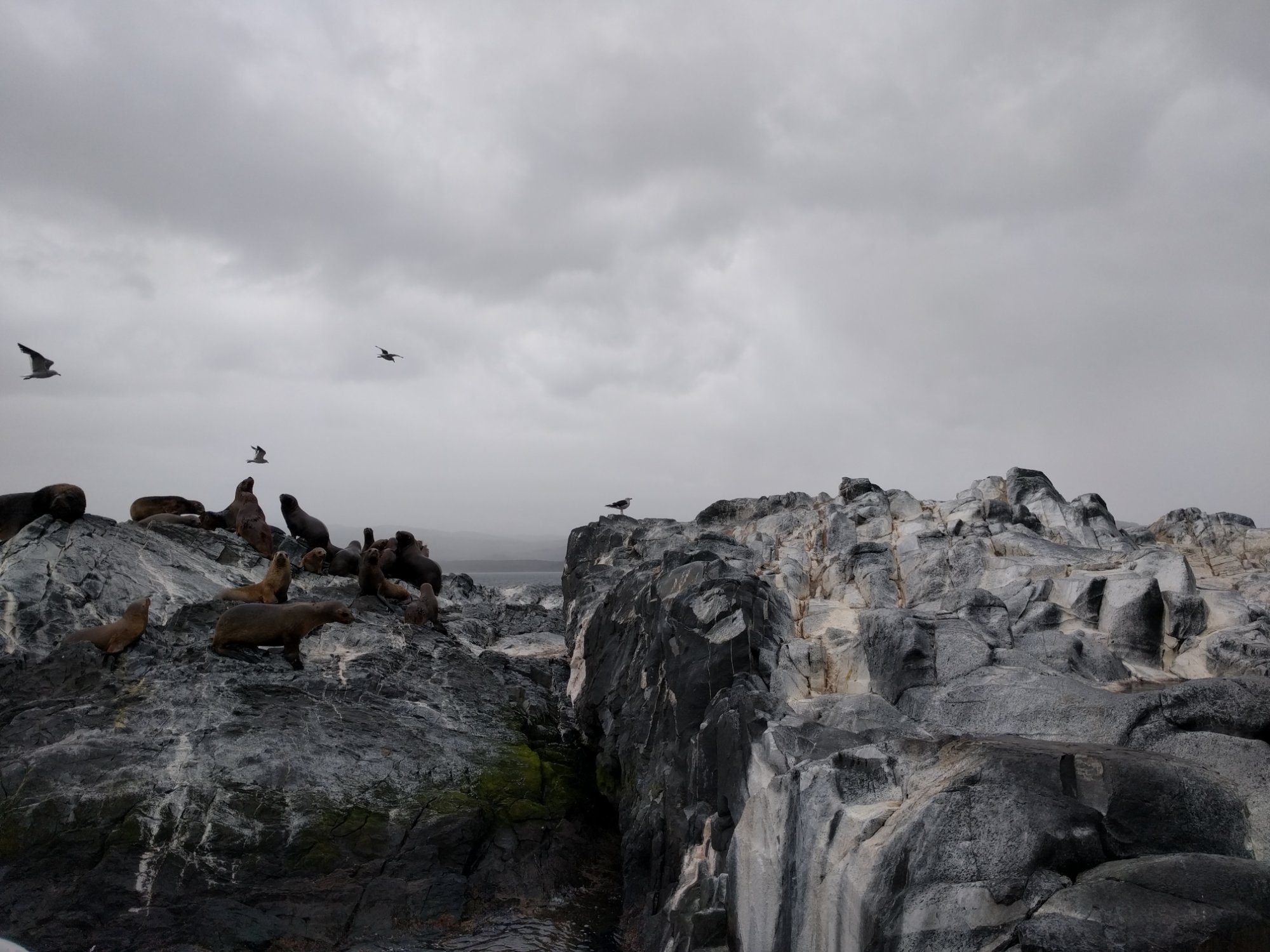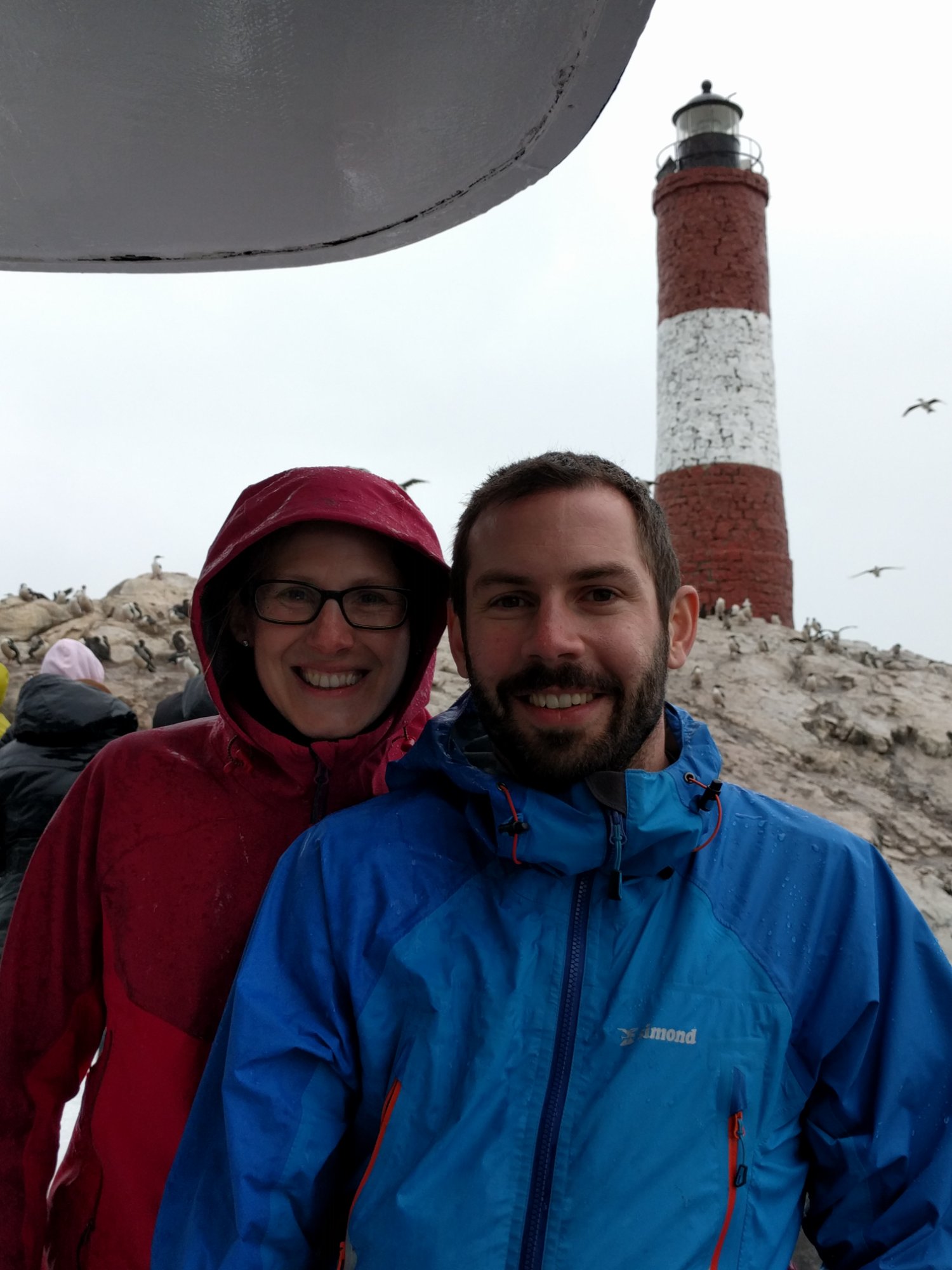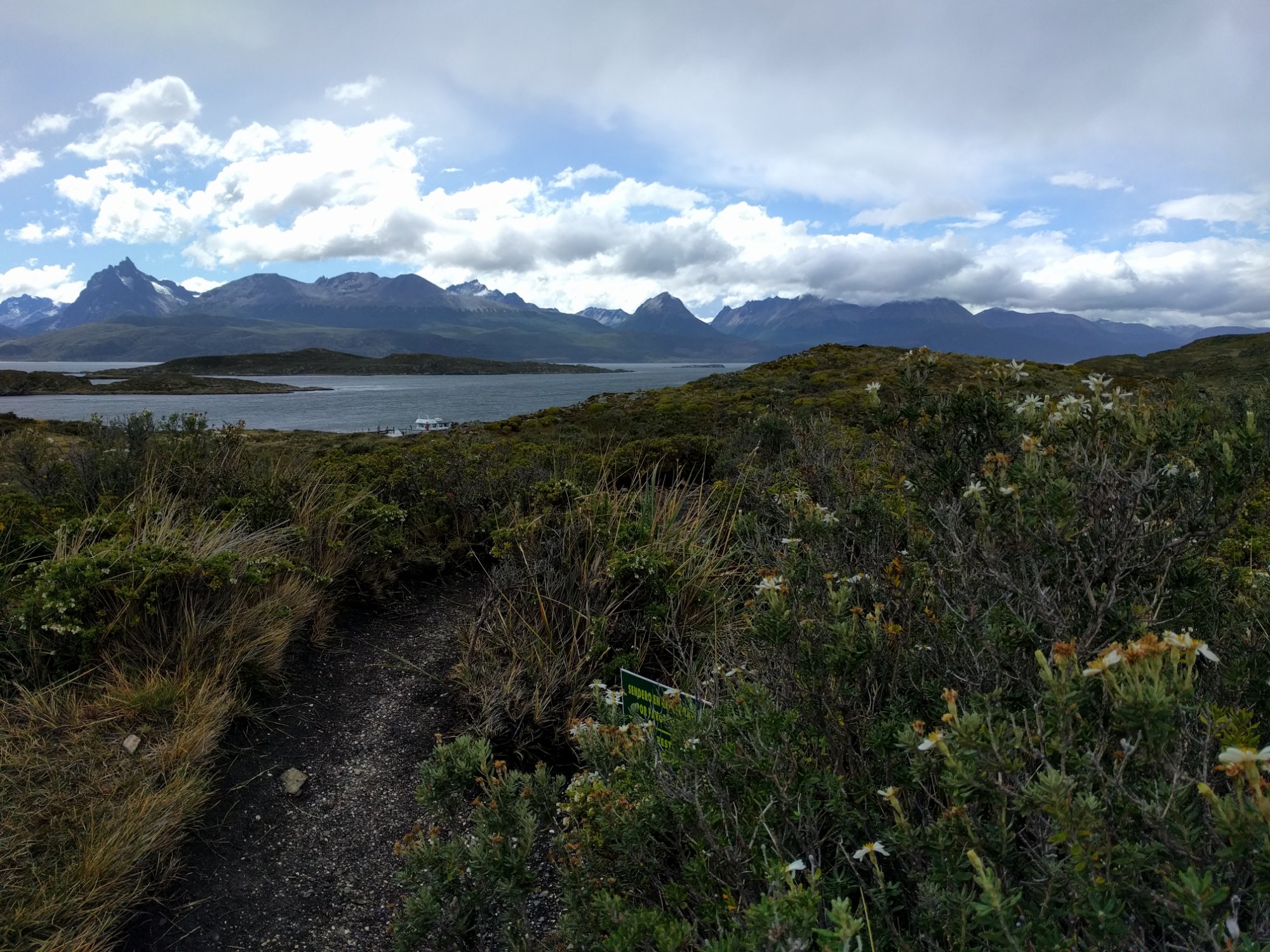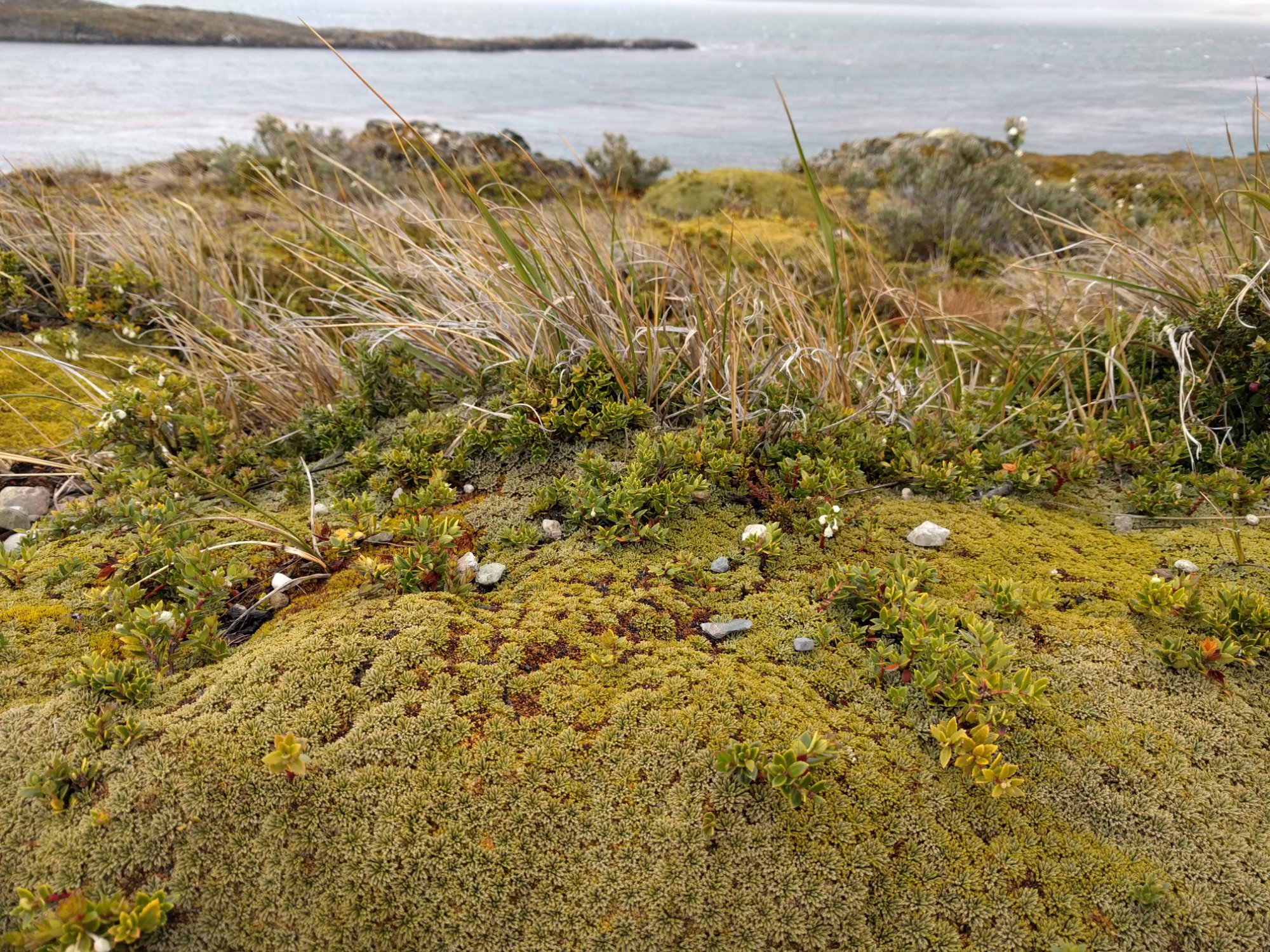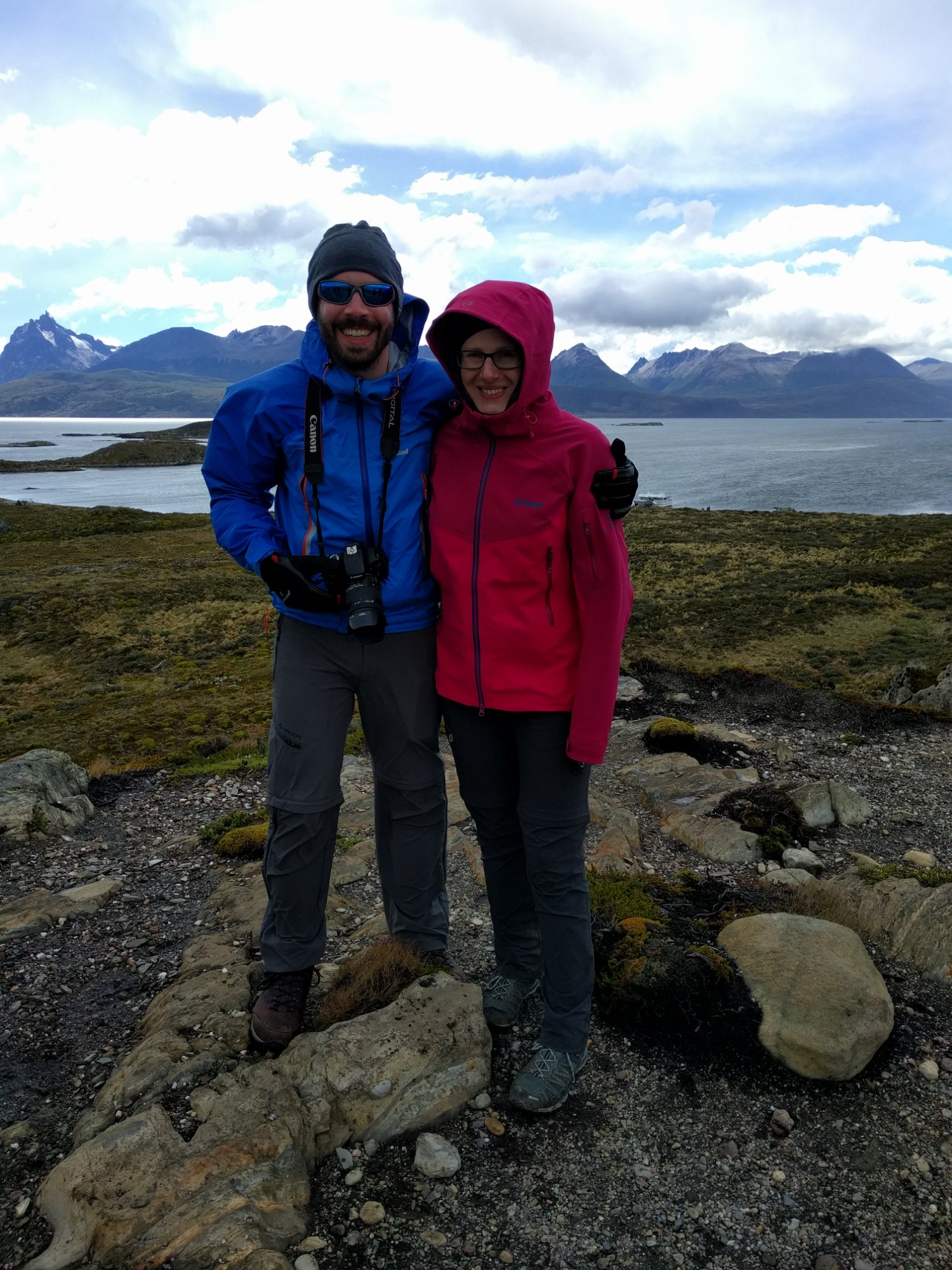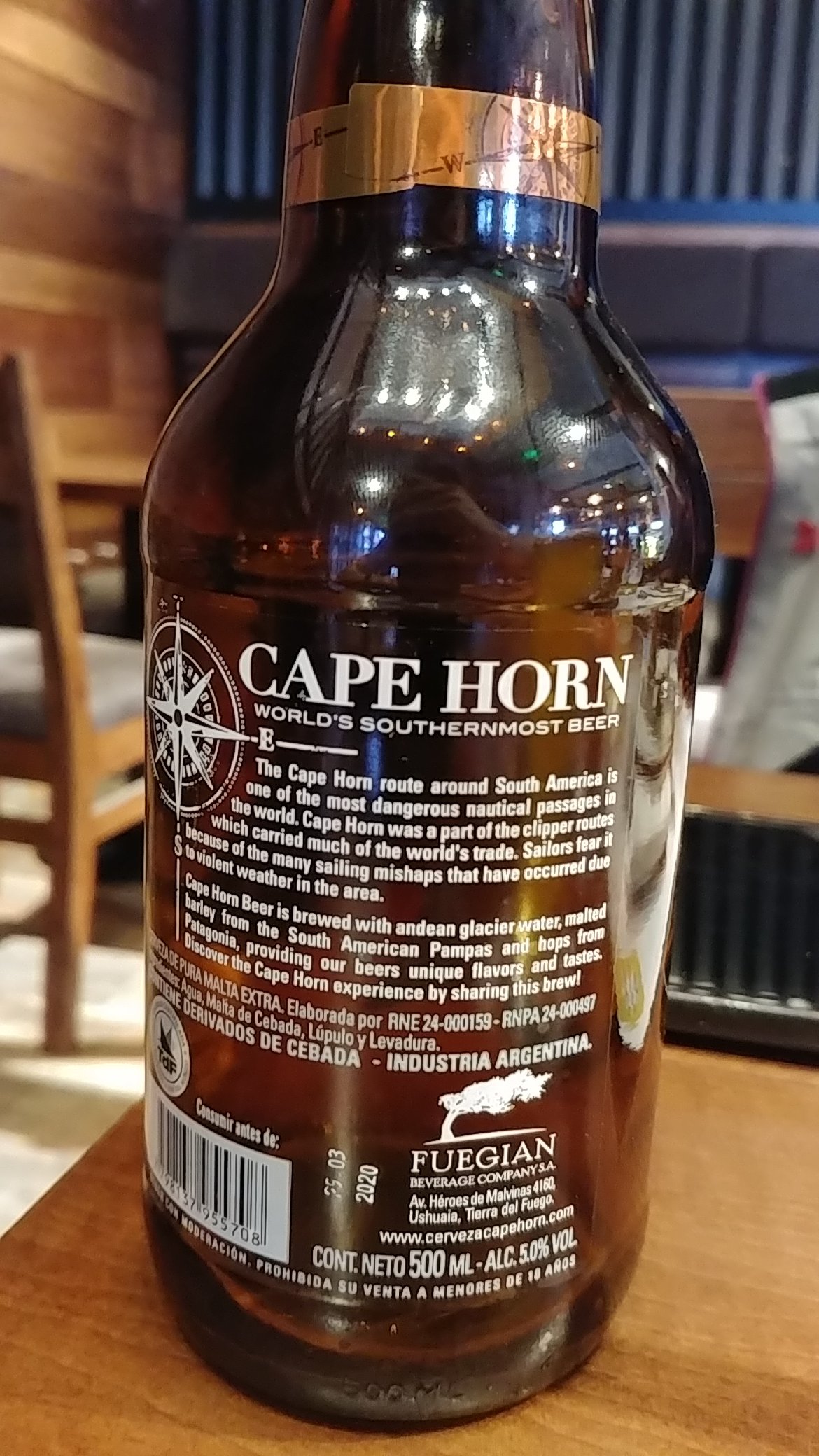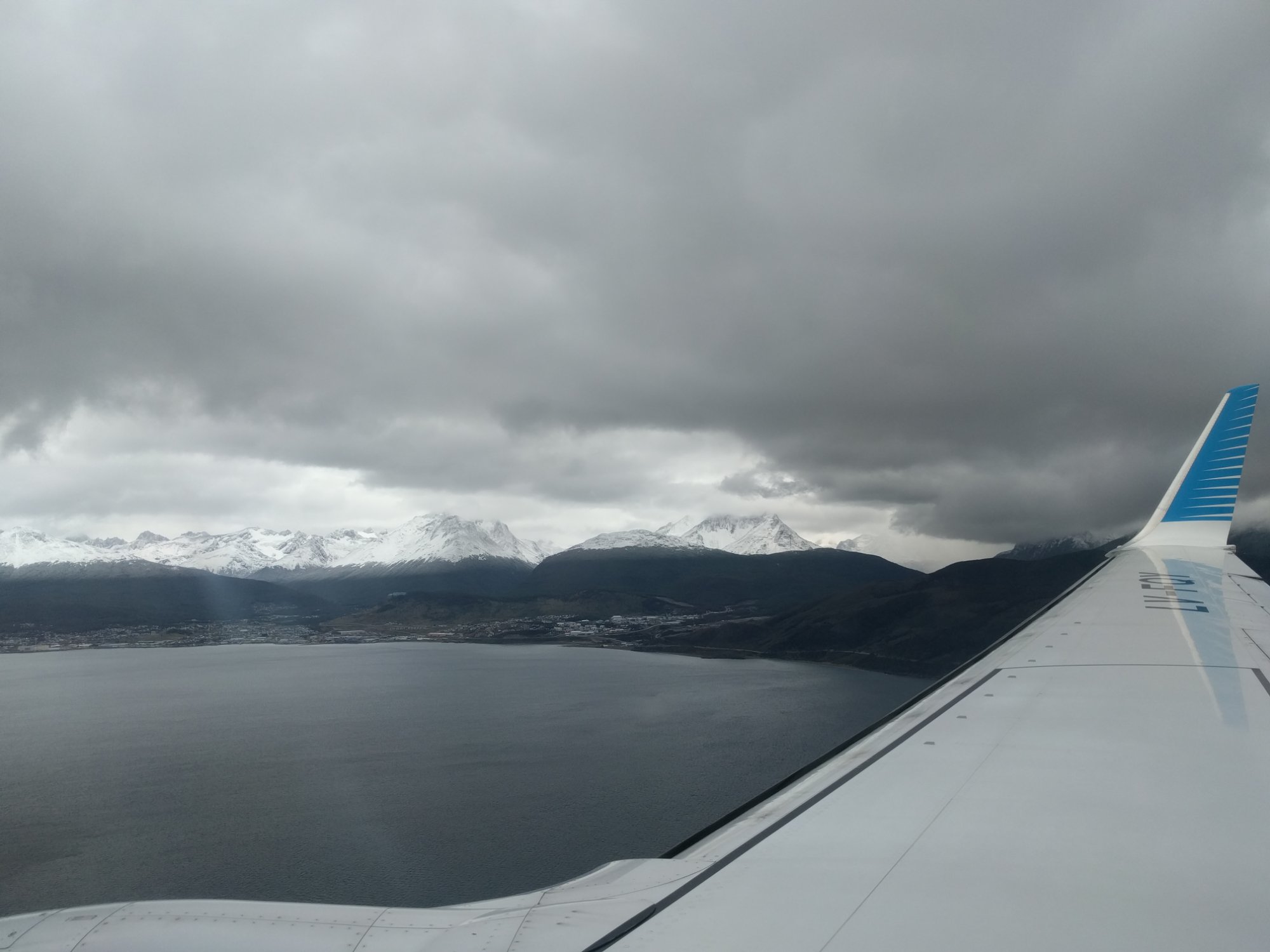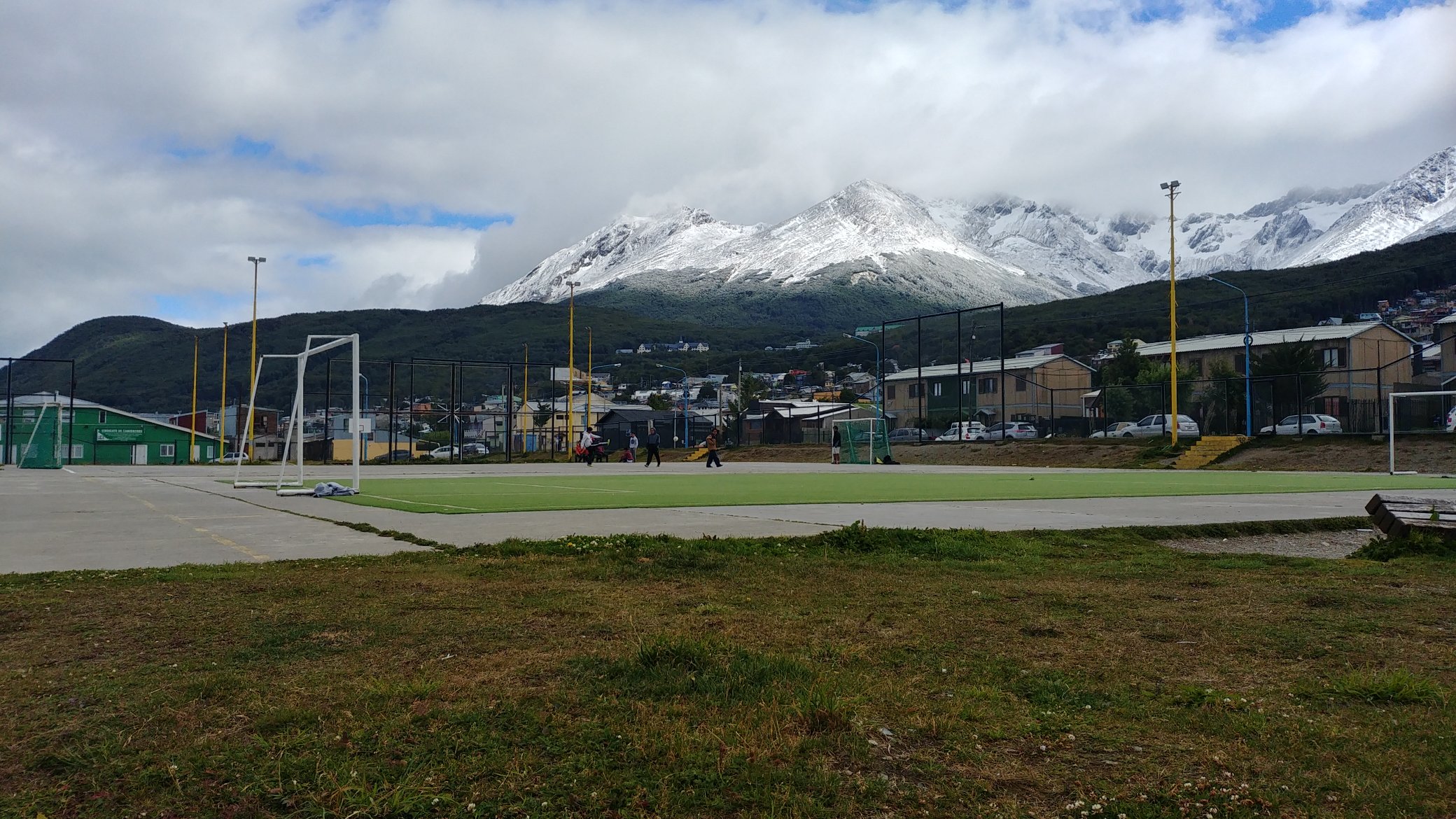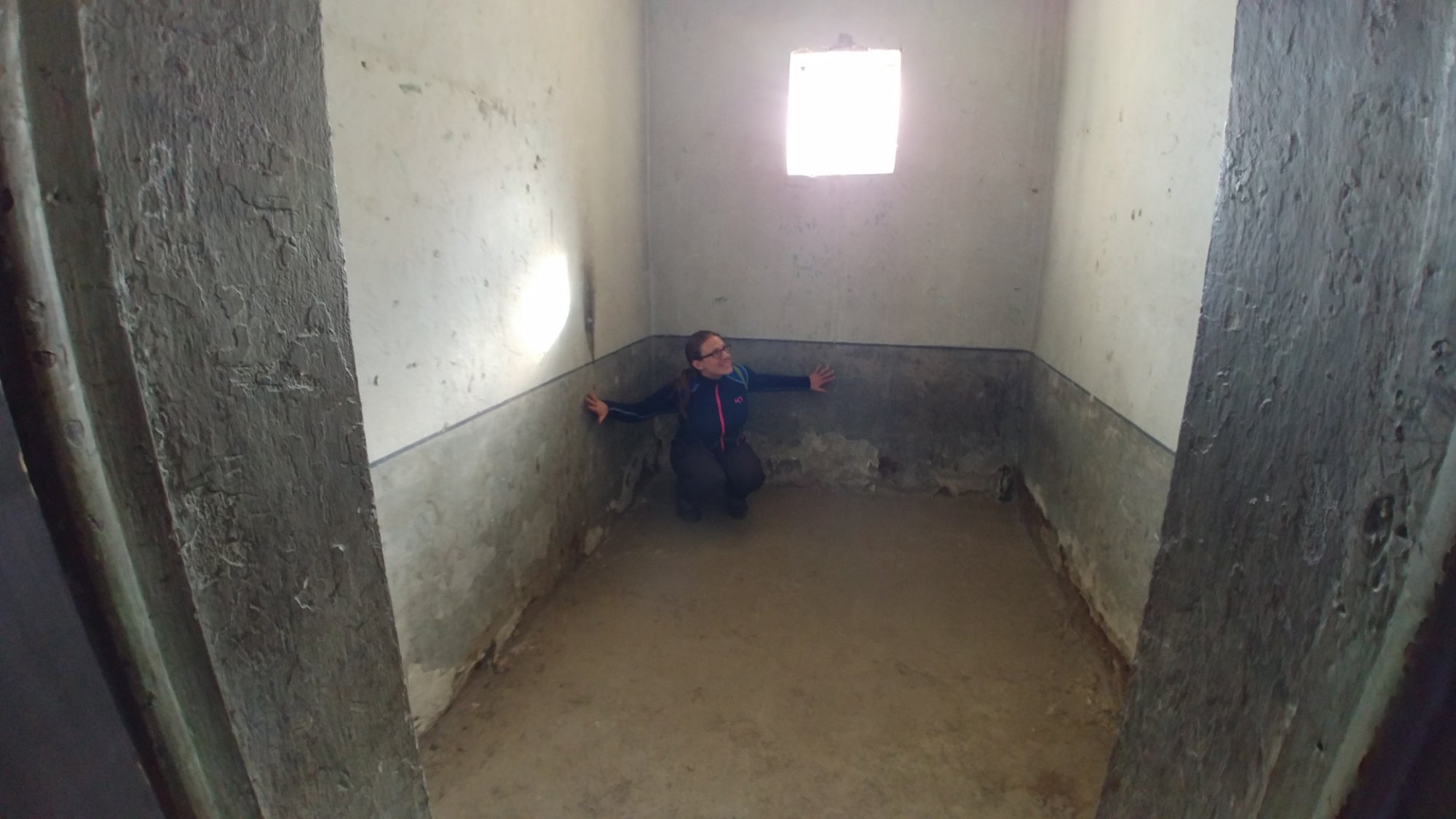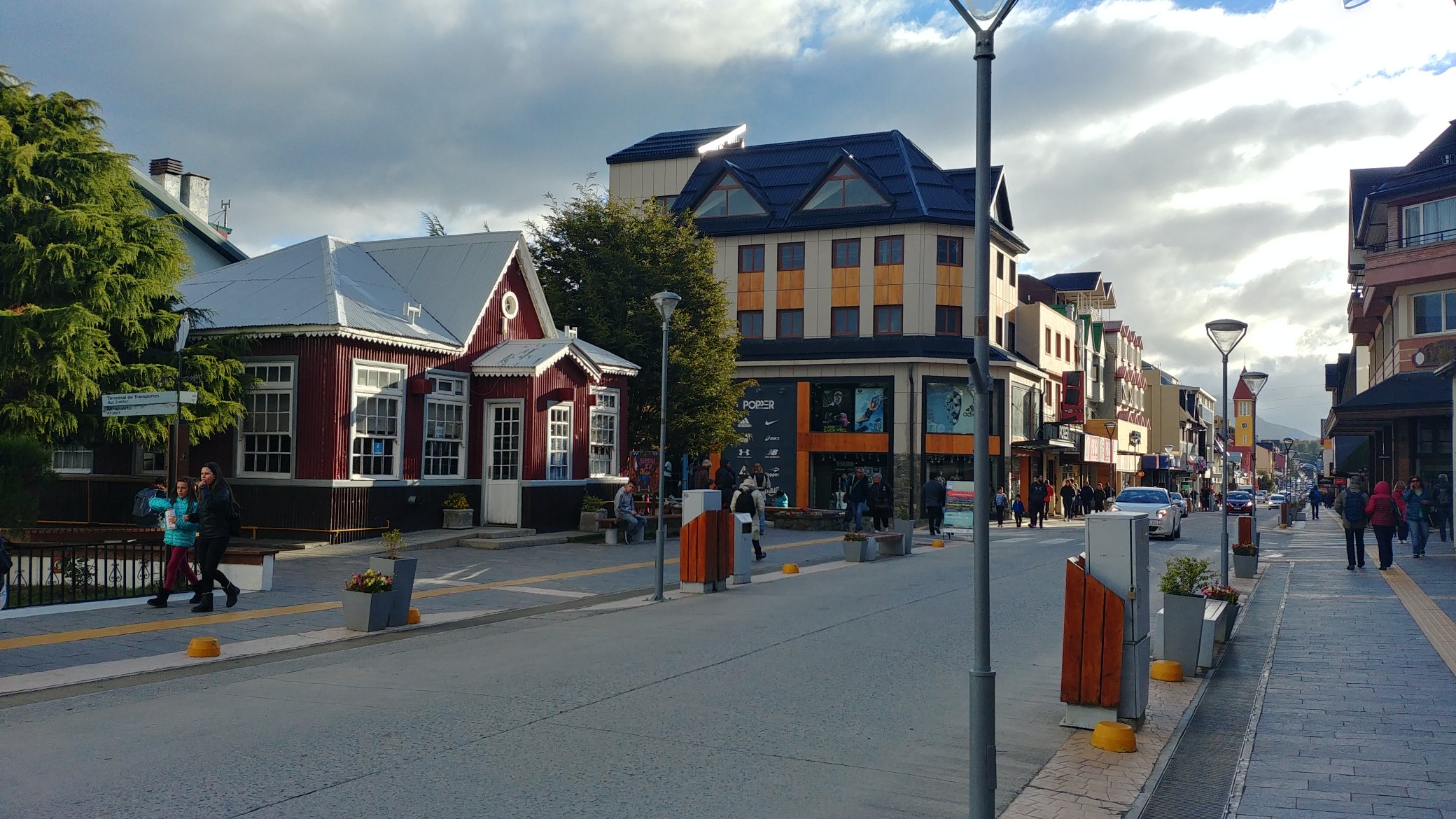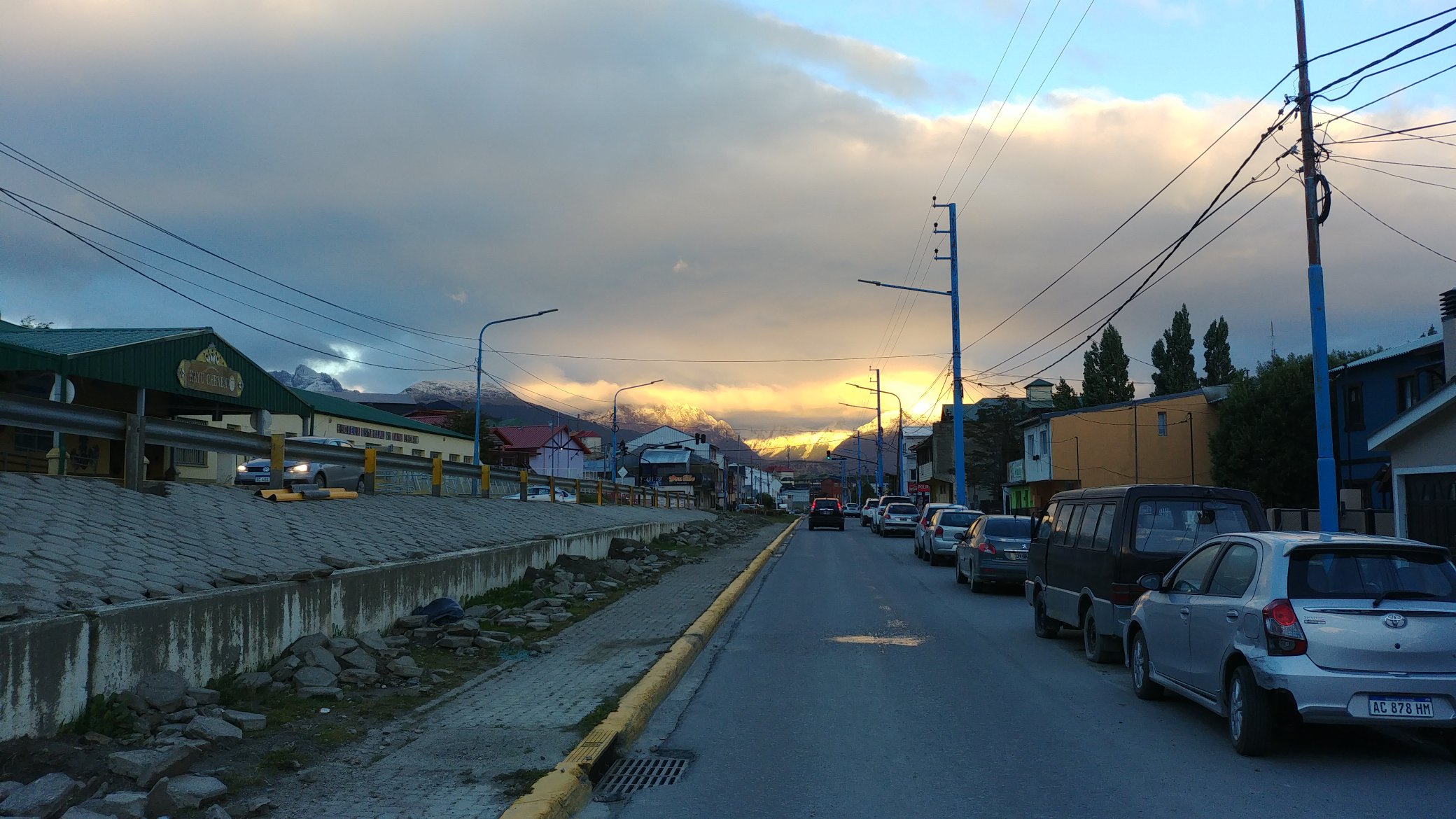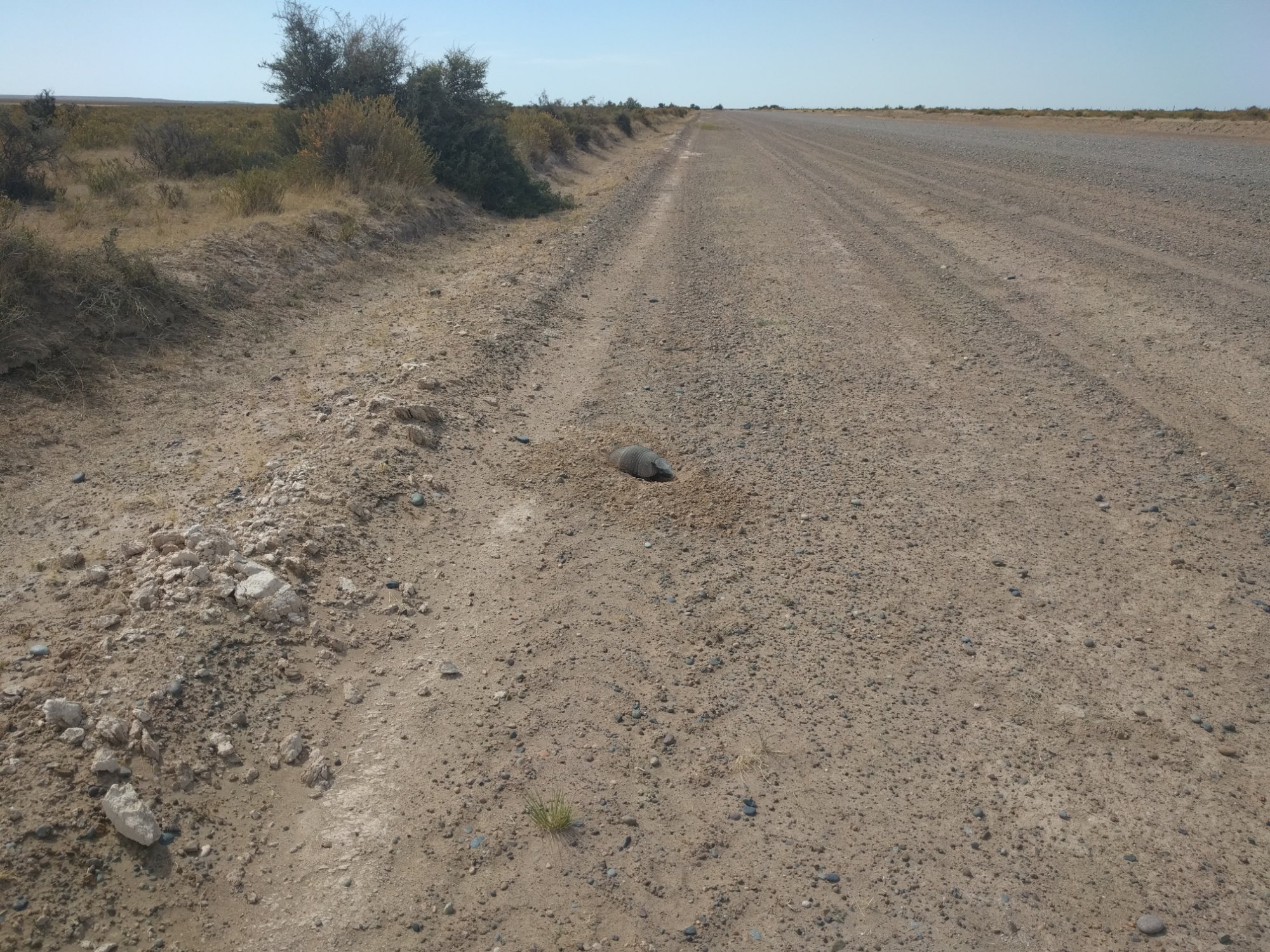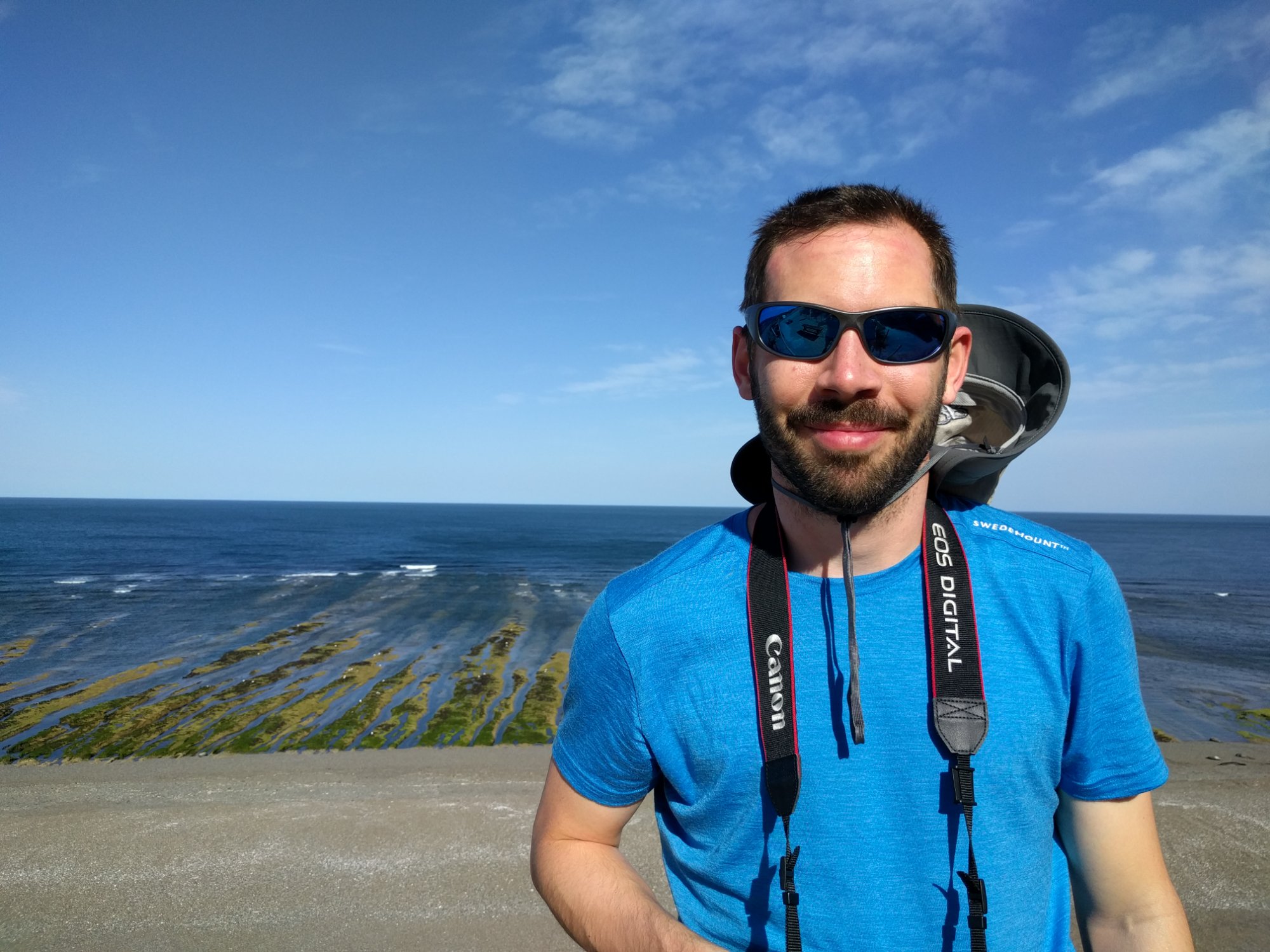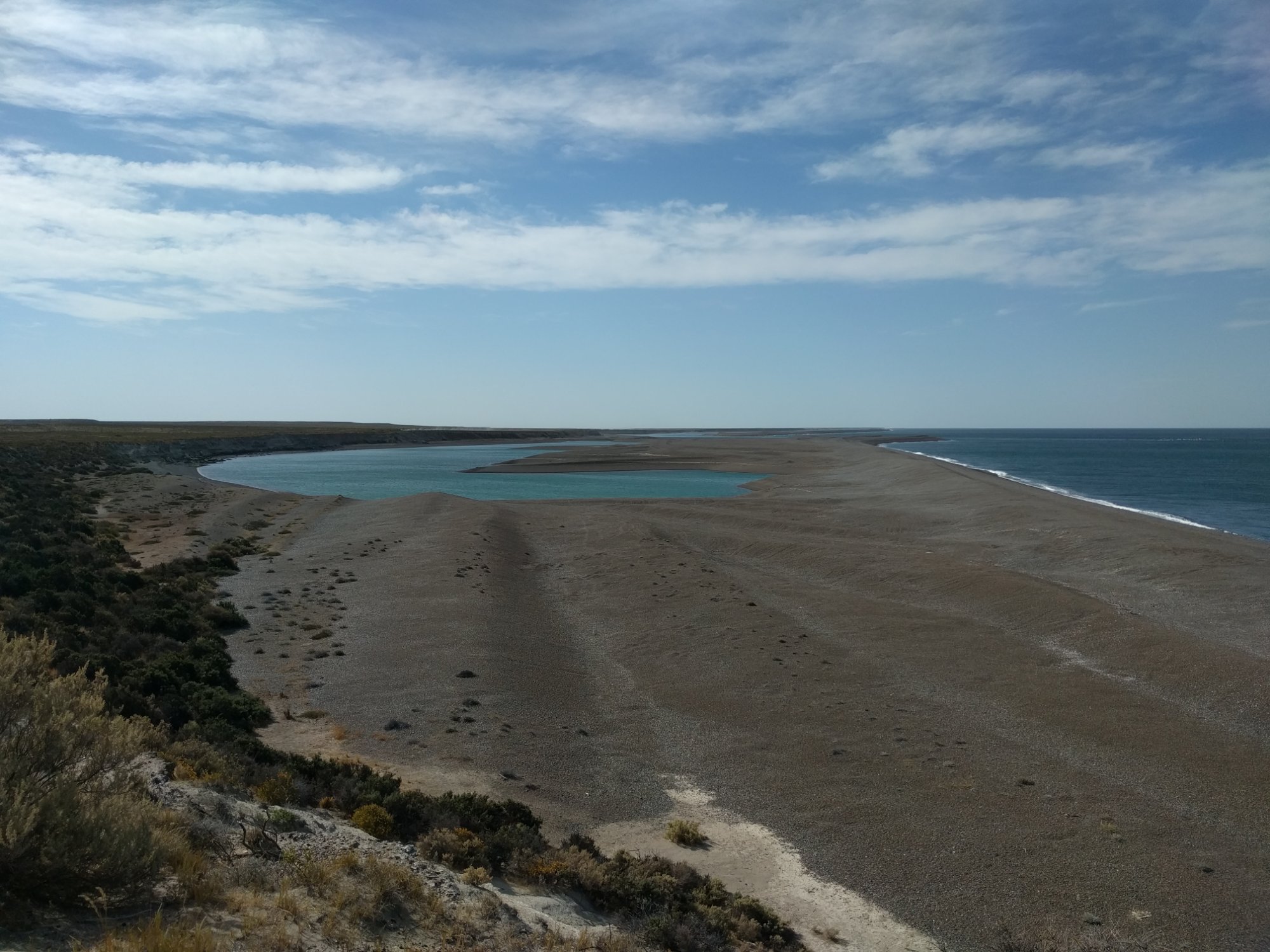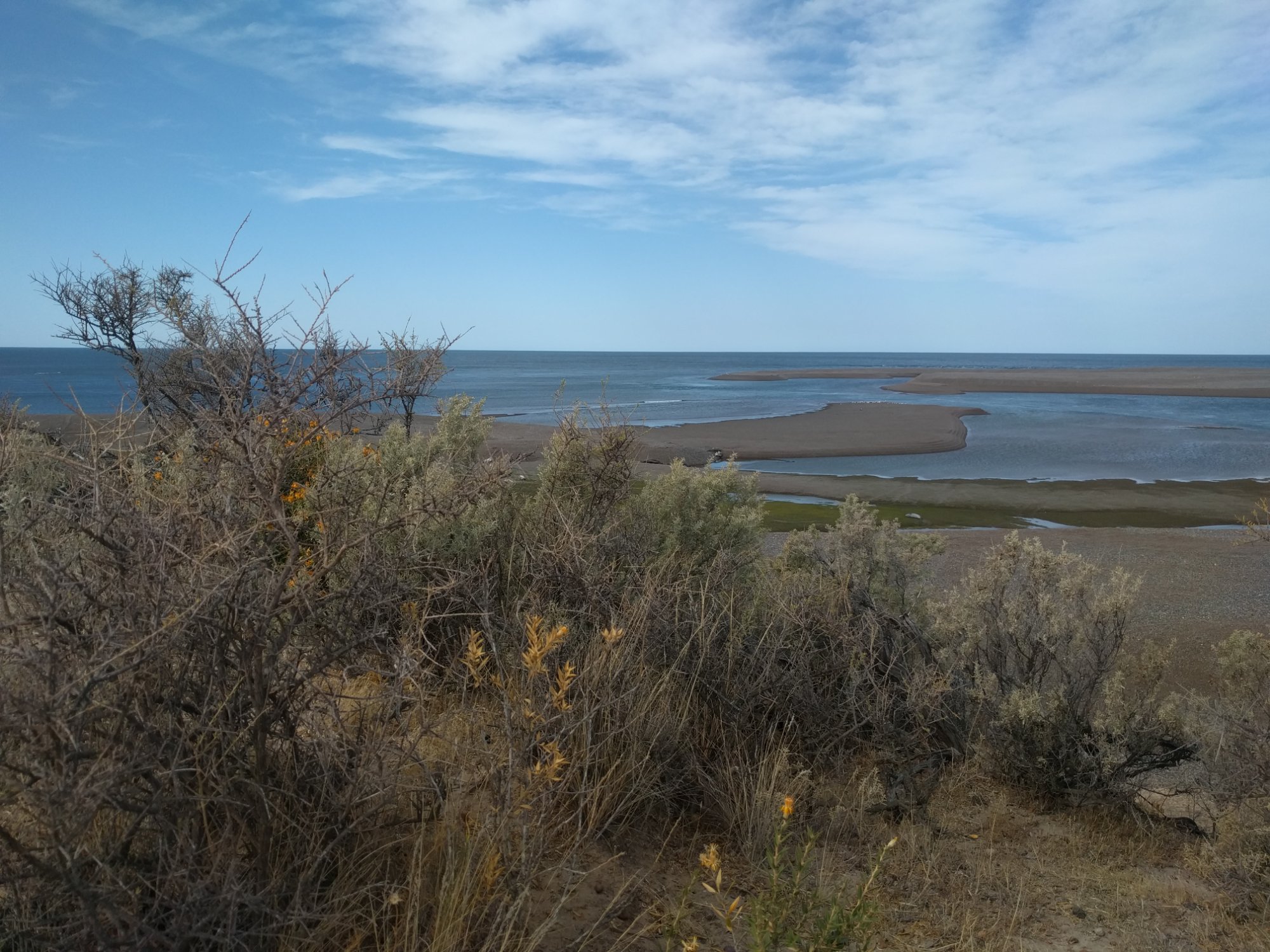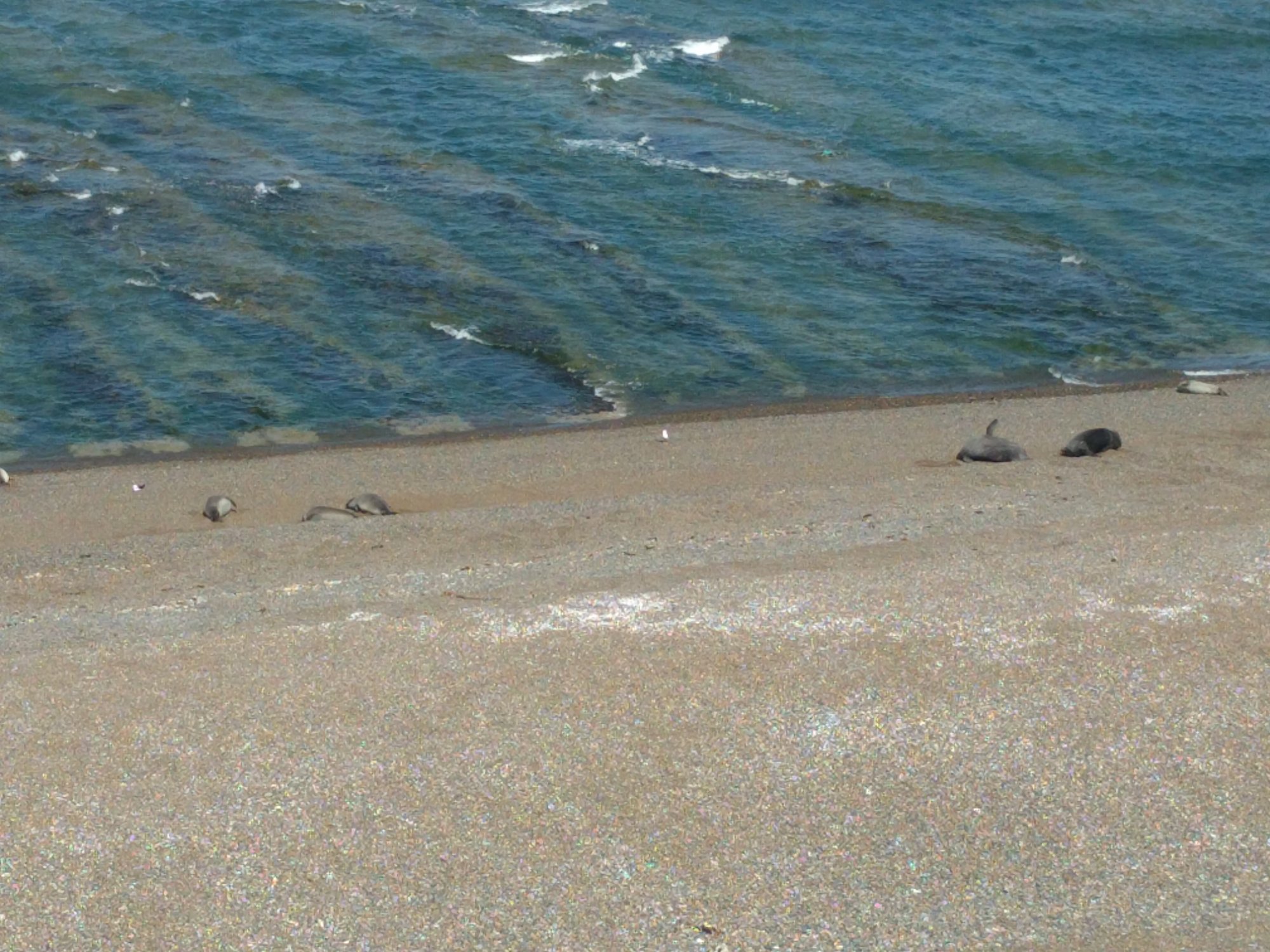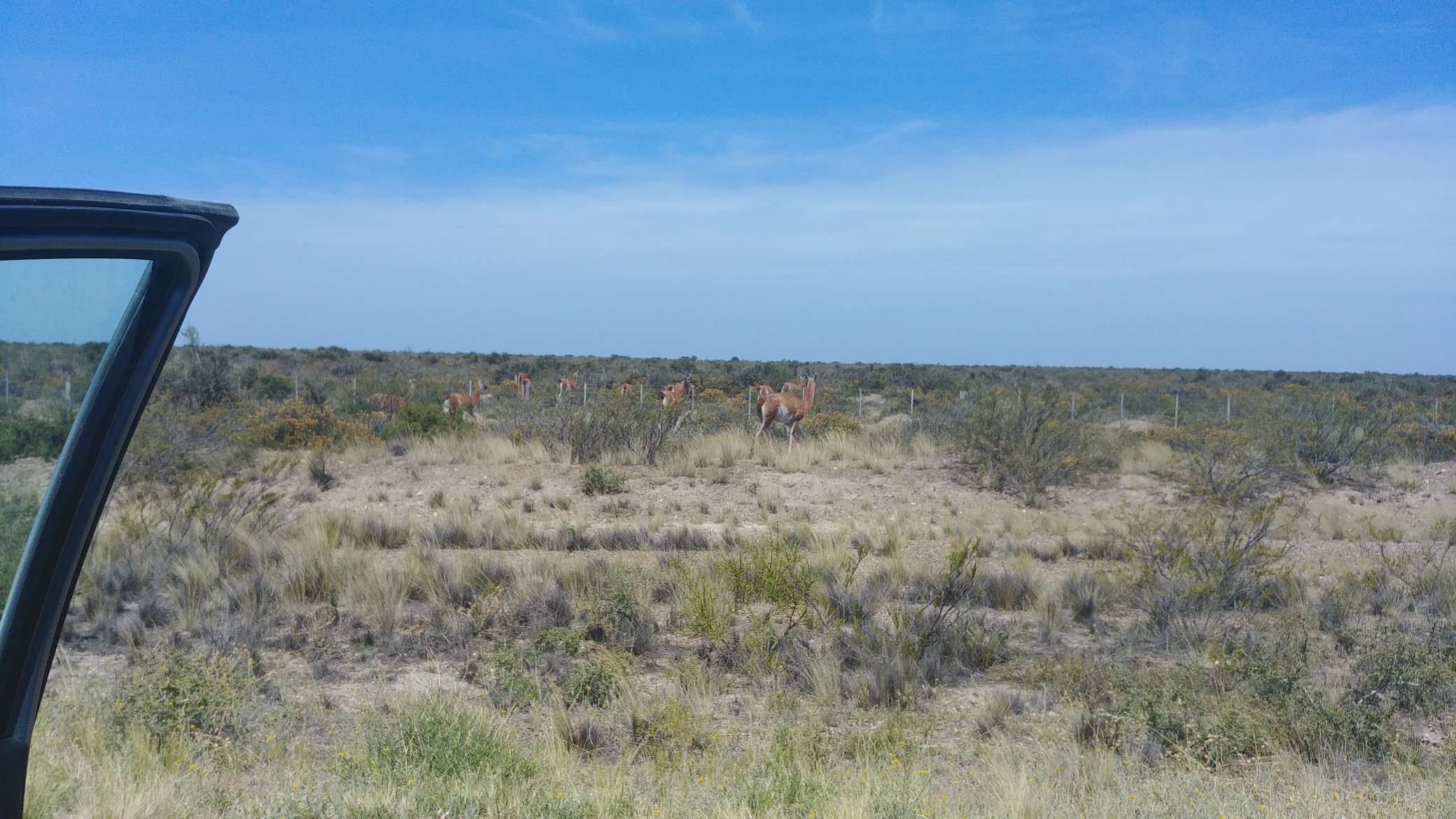All equipped with outdoor and camping gear as well as food for three days, we got a cab to take us to the starting point of our hike Northeast of Ushuia. The first part led us through a beautiful forest right next to colorful swamp lands and huge amounts of dead trees (apparently caused by the introduced north American beavers that flood huge areas by building dams and the rising water then kills the trees) with snow covered mountains in the background. The first real challenge required us to cross a river to enter the swamp. Easier said then done, as the water was painfully cold so we had to be very quick. Right after that the next challenge was to find the right path through the marshlands, as the trail was not marked and we only had a GPS trail. A couple of hours later we joined the river again and passed a spooky forest with animal bones scattered along the way. Eventually we reached our first camp site for the night, where we enjoyed the last rays of sunshine over the valley with a cup of Vino Tinto.
The morning after, our path led us up the hill towards the Paso Valdivieso which we scaled in about 2h. After reaching the top, we were rewarded with amazing outlooks over the adjacent mountains and the numerous glacial further down. After descending to one of these lakes, Paso Mariposa was waiting for us, and as it turned it would the greatest quest of the trip. A gruesome ascent through steep scree fields accompanied by probably the strongest wind we had experienced so far (luckily uphill) that almost blew us over. The subsequent descent was not much easier as following the GPS trail through steep cliffs crowded with thorn bushes and burnt trees turned out to not be trivial at all… Following another river and crossing several swamps, we could our second camp site and after a health meal of noodle soup with some more red wine, we fell into our well deserved sleep to give our aching legs some rest.
The next morning we woke with fresh energy and after a quick breakfast started the ascent to the last pass on our way, the Paso Beban. It turned out that it actually consisted of two separate passes but with only a couple of meters in descent in between, neither of them being particularly challenging compared to the hardship of the previous day. Then all we had to do was go down… But again, vast swamplands “paved” our way and more than once, we had to turn around as a beaver lake blocked our path. After a few more hours we finally reached a sign announcing a shelter but, the first sign of civilization we had seen in three days. From there it was only another two hours down to the road, which we reached quite exhausted. Then it was only to hitch a hike for the 25km back to Ushuaia, as the host of our hostel had said… 30mins later, a myriad of cars having passed us, showing us various signs that we couldn’t decipher, talking to some construction workers closely to convince them in vain to call us a cab, a father with his three daughters, in the car stopped and whisked us over. We squeezed into the car and learned that they were from Buenos Aires and in vacation down south and that the father had once waited a long time for a hitchhike, so he could understand our desperation. They drove us back to the city center refusing to accept a little gratitude from us as it was “just the right thing to do”, lovely!
We went straight to a bar, a beer never tasted better, and then decided to celebrate our accomplishment with a dish of the elusive King Crab that lives in the depths of the oceans around the islands. In the queue for entering the restaurant, we met two Swabish retirees from Heilbronn and we connected right away so we joined them at their table, relating stories about Binokel, Lemberger and their poor wives “having” to stay home alone without them…
Deutsche Übersetzung:
Mit Outdoor- und Campingausrüstung sowie Verpflegung für drei Tage ausgestattet, bekamen wir ein Taxi, das uns zum Ausgangspunkt unserer Wanderung nordöstlich von Ushuia brachte. Der erste Teil führte uns durch einen schönen Wald direkt neben farbenfrohen Sumpfgebieten und riesigen Mengen toter Bäume (verursacht durch die eingeführten nordamerikanischen Biber, die riesige Flächen durch den Bau von Dämmen überfluten und das steigende Wasser die Bäume tötet) mit schneebedeckten Bergen im Hintergrund. Die erste echte Herausforderung bestand darin, dass wir einen Fluss überquerten, um in den Sumpf zu gelangen. Leichter gesagt als getan, da das Wasser schmerzhaft kalt war, mussten wir sehr schnell sein. Gleich danach bestand die nächste Herausforderung darin, den richtigen Weg durch das Marschland zu finden, da der Weg nicht markiert war und wir nur einen GPS-Trail hatten. Ein paar Stunden später kamen wir wieder an den Fluss und passierten einen gruseligen Wald mit Tierknochen, die auf dem Weg verstreut waren. Schließlich erreichten wir unseren ersten Campingplatz für die Nacht, wo wir bei einem Glas Vino Tinto die letzten Sonnenstrahlen über dem Tal genossen.
Am Morgen danach führte uns unser Weg den Hügel hinauf zum Paso Valdivieso, den wir in etwa 2 Stunden erklimmen konnten. Nachdem wir den Gipfel erreicht hatten, wurden wir mit tollen Ausblicken über die angrenzenden Berge und die zahlreichen Gletscherseen weiter unten belohnt. Nach dem Abstieg zu einem dieser Seen wartete der Paso Mariposa auf uns, und wie sich herausstellen sollte, war es die größte Aufgabe der Wanderung. Ein heftiger Aufstieg durch steile Geröllfelder begleitet von dem wahrscheinlich stärksten Wind, den wir bisher erlebt hatten (zum Glück bergauf), der uns fast überwältigte. Der anschließende Abstieg war nicht viel einfacher, da sich das Folgen des GPS-Pfades durch steile Klippen voller Dornensträucher und verbrannter Bäume als gar nicht trivial erwies… Nach einem gesunden Essen mit Nudelsuppe und etwas mehr Rotwein fielen wir in unseren wohlverdienten Schlaf, um unseren schmerzenden Beinen etwas Ruhe zu geben.
Am nächsten Morgen wachten wir mit frischer Energie auf und begannen nach einem kurzen Frühstück den Aufstieg zum letzten Pass auf unserem Weg, dem Paso Beban. Es stellte sich heraus, dass es sich tatsächlich um zwei getrennte Pässe handelte, die jedoch nur etwa einen Kilometer voneinander entfernt lagen, wobei keiner der beiden im Vergleich zu den Schwierigkeiten des Vortages eine besondere Herausforderung darstellte. Dann mussten wir nur noch nach unten gehen… Aber wieder “ebneten” uns riesige Sumpfgebiete den Weg und mehr als einmal mussten wir umdrehen, als uns ein Bibersee den Weg versperrte. Nach ein paar weiteren Stunden erreichten wir schließlich ein Schild, das eine Schutzhütte ankündigte, das erste Zeichen der Zivilisation, das wir in drei Tagen gesehen hatten. Von dort aus waren es nur noch zwei Stunden bis zur Straße, die wir ziemlich erschöpft erreichten. Dann hieß es nur noch per Anhalter 25 km zurück nach Ushuaia zu fahren, wie der Gastgeber unseres Hostels gesagt hatte… 30 Minuten später, unzählige Autos waren an uns vorbei gefahren die uns verschiedene zeigten gaben, die wir nicht entziffern konnten, wir sprachen mit einigen Bauarbeitern, um sie vergeblich davon zu überzeugen, uns ein Taxi zu rufen, stoppte ein Vater mit seinen drei Töchtern, im Auto um uns mitzunehmen. Wir drückten uns in das Auto und erfuhren, dass sie aus Buenos Aires und im Urlaub im Süden waren und dass der Vater einst lange als Anhalter gewartet hatte, und konnte deshalb unsere Verzweiflung verstehen. Sie fuhren uns zurück ins Stadtzentrum und weigerten sich, ein wenig Dankbarkeit von uns anzunehmen, denn es war “genau das Richtige”, sehr nett!
Wir gingen direkt in eine Bar, ein Bier schmeckte nie besser, und beschlossen dann, unsere Leistung mit einem Gericht der mysteriösen Königskrabbe zu feiern, die in den Tiefen der Ozeane um die Inseln lebt. In der Schlange zum Betreten des Restaurants trafen wir zwei schwäbische Rentner aus Heilbronn und wir verstanden uns sofort, also schlossen wir uns ihnen an ihrem Tisch an und erzählten Geschichten über Binokel, Lemberger und ihre armen Frauen, die “allein zu Hause bleiben müssen”, ohne sie…
